When you hear the phrase ‘fallen giant’, you may be forgiven for thinking of former Bundesliga titans FC Schalke.
Cast your mind back 12 seasons ago for a moment — FC Schalke 04 had reached the UEFA Champions League semi-final in 2010/11, having put current champions Internazionale to the sword after the Italian club’s treble-winning campaign under José Mourinho.
Ralf Rangnick was the man at the helm at the time, and fittingly, the German giants were eliminated from the final four by finalists Manchester United, the team Rangnick would lead 11 years later. The less said about that six-month stint, the better.
Nevertheless, Schalke were a force to be reckoned with. Players like Manuel Neuer and Joël Matip resided within the squad — two players who have gone on to win some of football’s greatest honours including countless European titles, with the German goalkeeper even picking up a World Cup winner’s medal for his troubles.
Benedikt Höwedes and Julian Draxler were also on that side, two more players who lifted the glorious golden trophy in Rio on that cool and hazy afternoon in July 2014.
Furthermore, Rangnick had Real Madrid legend Raúl within his ranks, one of European football’s greatest goalscorers. This Schalke side had talent in abundance.
We can even go one step closer to the present day, skipping to the 2017/18 campaign. Schalke battled hard to finish in second place, above Borussia Dortmund, Bayer Leverkusen and Julian Nagelsmann’s Hoffenheim.
This also meant that Domenico Tedesco’s men qualified for the Champions League ahead of the 2018/19 season; while their league form collapsed the following year, Schalke reached the knockout phase of the esteemed and ever-coveted European competition.
Two years later, on April 20, 2021, after a 1-0 home defeat to Arminia Bielefeld, Schalke’s relegation to the second division was confirmed, having accumulated a lowly 16 points in total.
Tension around the club reached boiling point as supporters rioted against players and others deemed liable for the demise of one of Germany’s top clubs. The Veltins-Arena became a lion’s den, and these lions were hungry.
The club had entered into an incredibly apprehensive financial situation where bankruptcy was a real possibility over the next 12 months, spurred by the pitfalls of COVID-19 and the Russian invasion of Ukraine, causing Schalke to lose Gazprom as a sponsor. There was no clear solution to rise from the seabed — the ship had well and truly sunk.
Thankfully, Schalke’s stay in the 2. Bundesliga wasn’t long-lived. Within a season, caretaker boss Mike Büskens took Die Knappen back to the top flight, winning the league by two points over another former giant of Deutschland: Werder Bremen.
The former VfL Bochum head coach Thomas Reis was the man tasked with keeping Schalke in the promised land. Unfortunately, this hasn’t gone to plan so far, with the club sitting rock bottom of the Bundesliga, a familiar sight for the North Rhine-Westphalia club.
This tactical analysis piece will be a deep dive into the last few seasons, documenting the tactics used during the fall, the rise, and the fall again of FC Schalke. It will be an analysis using data and other means to cut through the decline of Schalke from 2019 to the present in the form of a team scout report.
Wagner’s winning ways and catastrophic collapse – 2019/20
Having guided Huddersfield Town into the Premier League against all odds and kept the Terriers in the division for another year, David Wagner was quickly garnering a reputation for being one of the brightest minds in the game.
The German-American who developed his trade with Borussia Dortmund II and mastered it in West Yorkshire could not turn down a return to the club he played for from 1995 to 1997 as a striker — winning the 1997 UEFA Cup against Roy Hodgson’s Inter.
Wagner started off impressively at Schalke. By mid-January, Die Knappen has lost merely three Bundesliga games, coming against Bayern Munich, Hoffenheim and Bayer Leverkusen, with just one defeat occurring at the Veltins-Arena.
The current Norwich City boss used a whole variety of formations during his time in North Rhine-Westphalia, namely the 4-4-2 diamond/4-3-1-2 which had become Schalke’s primary shape on the field of play.
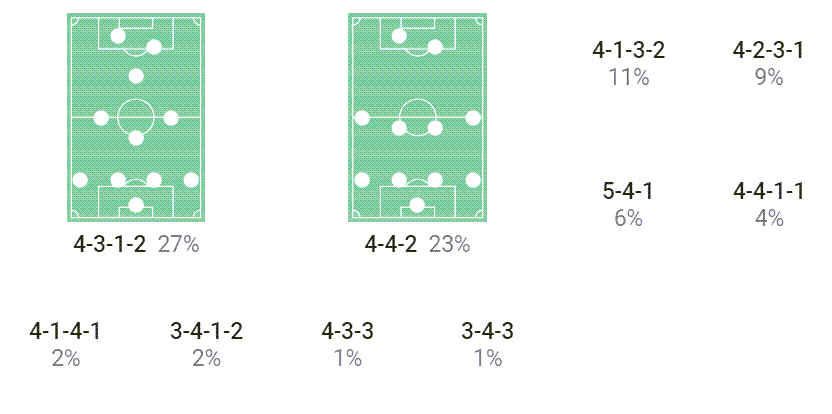
After a 2-0 home victory over Borussia Mönchengladbach in Gelsenkirchen on 17 January 2020, Schalke moved up to fourth place, level on points with champions Bayern Munich and just four points off RB Leipzig at the top.
Just over half the season had been completed by this point in time (or 53% of the league campaign, to be precise).
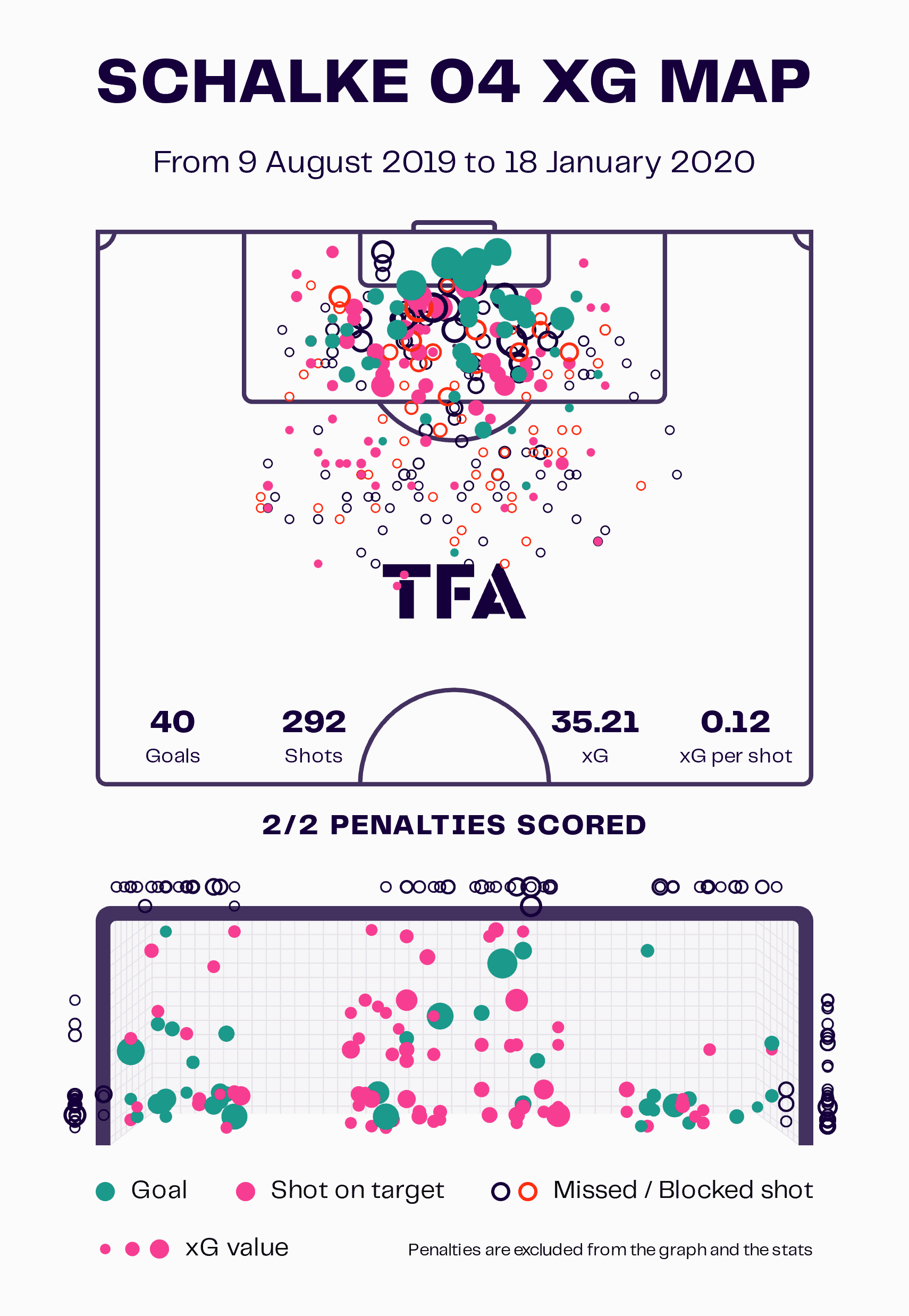
Goals were no allusion to the Royal Blues. Wagner’s style suited the players, and it looked as though there was a real possibility of qualifying for the 2020/21 Champions League. Having scored 40 goals in all competitions, Schalke were outperforming their xG of 35.21.
However, what ensued can only be described as catastrophic. This 2-0 triumph in January was to be the last time supporters celebrated a league victory for 358 days.
In the aftermath of the team’s victory at the Veltins-Arena on that frosty Friday night in January 2020, Schalke scored just another nine goals from then until the end of June.
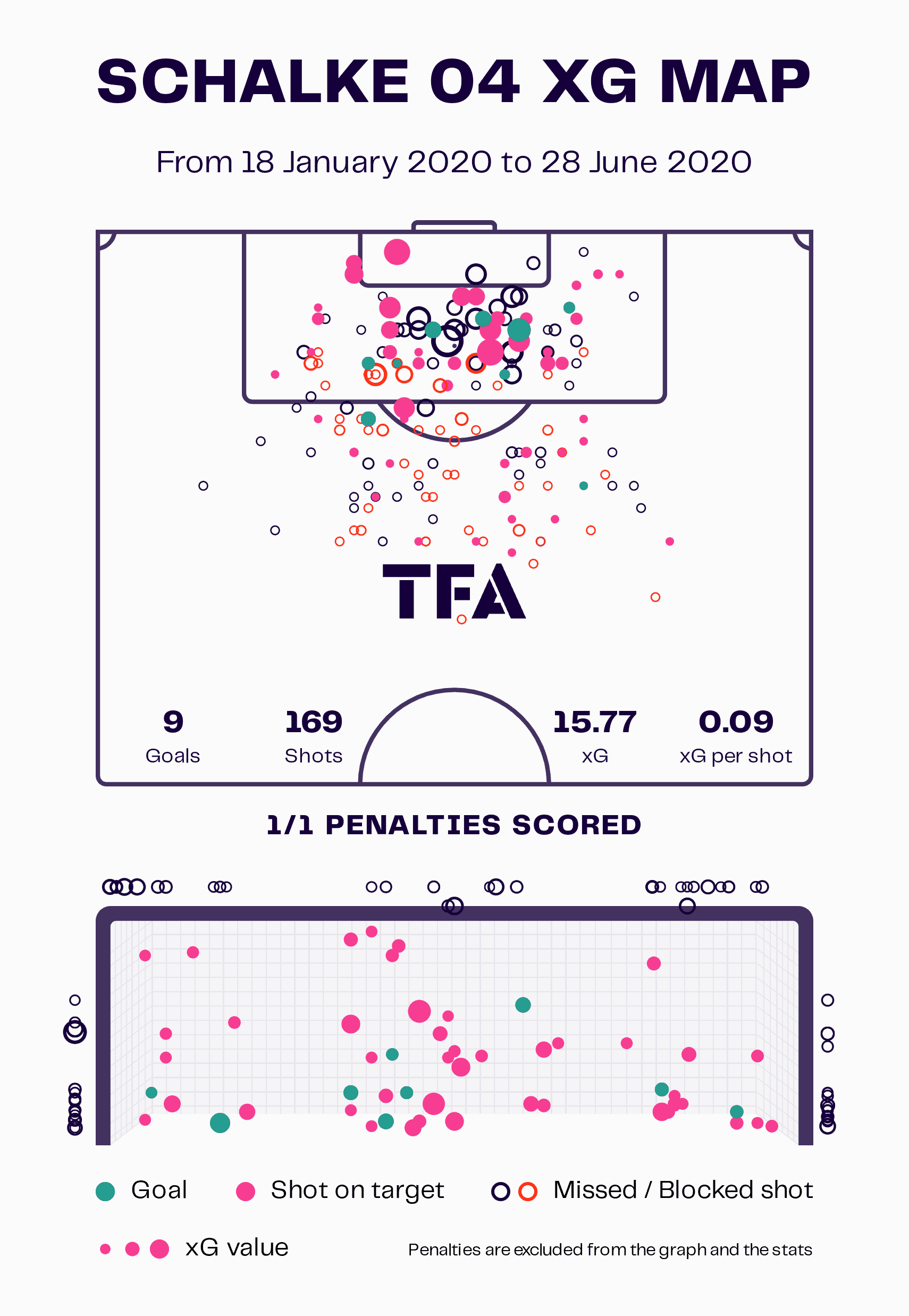
Granted, COVID upset the regular calendar and two months can be chalked off for the season’s stoppage, but nine goals in roughly four months of games is a colossal drop-off.
The tables had completely shifted on Wagner’s side who began underperforming their xG of 15.77 by a significant amount, while their xG per shot rate dropped from 0.12 on average to 0.09.
What was even more damning was Schalke’s defensive performances. The team faced an xG of 29.3 in the first 18 league matches, with the goalkeepers preventing 8.3 goals in total.
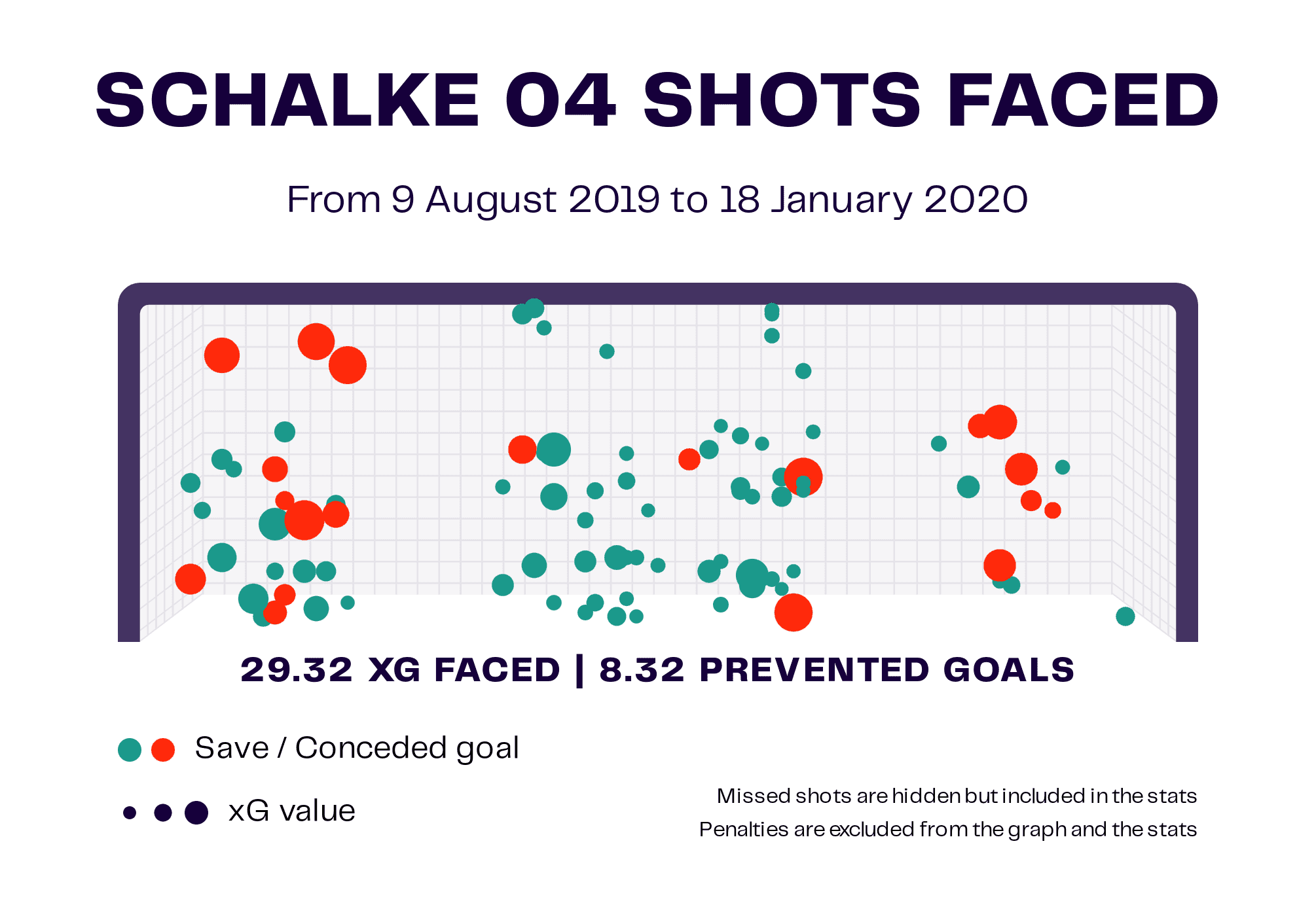
In less time, this rapidly worsened. In the proceeding 16 league games, Schalke conceded an xG of 33.73 and the goalkeepers actually cost the team 4.27 goals in the meantime.
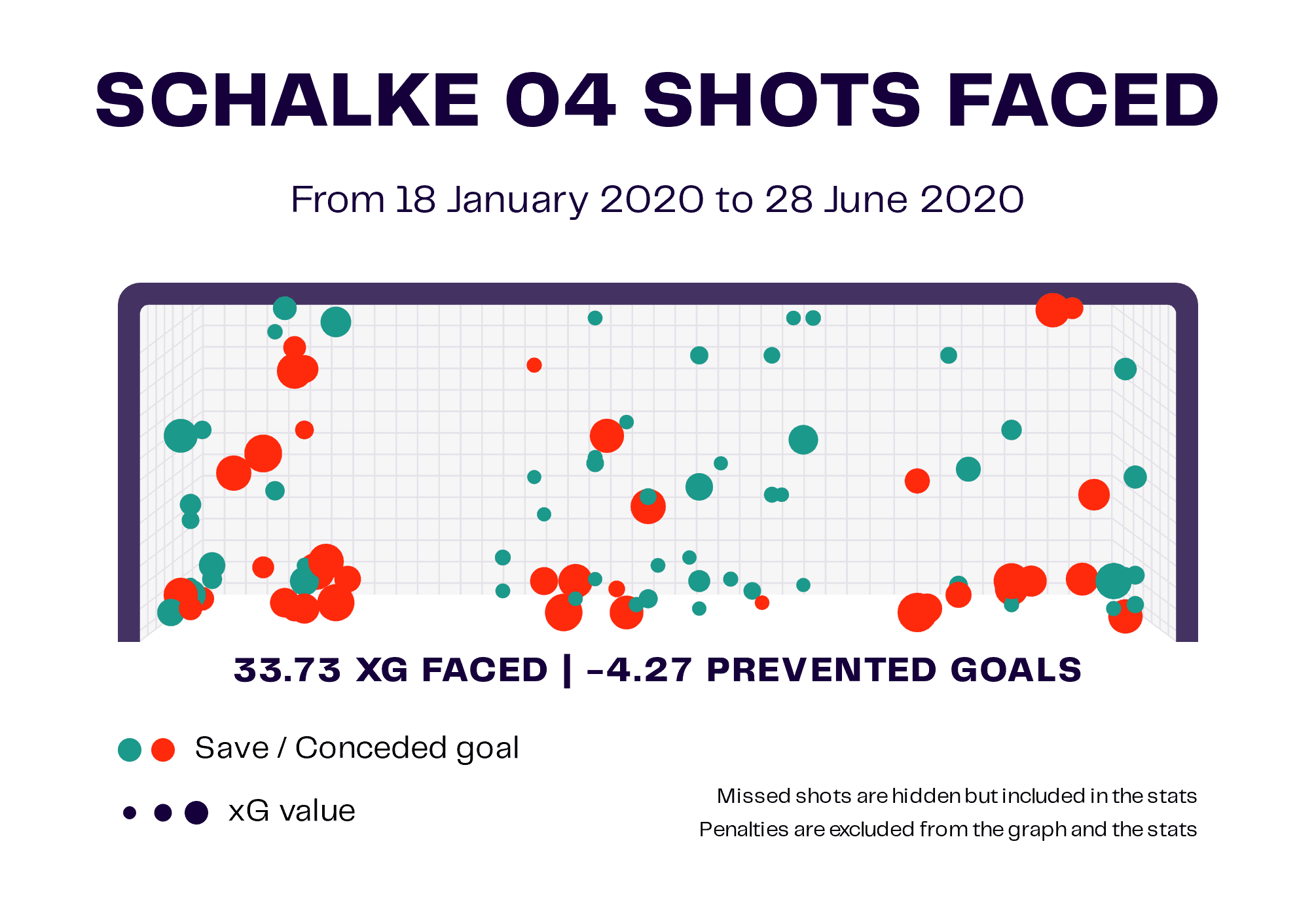
Fans lost patience with Wagner. His methods worsened with time and the drop-off in performance levels from Schalke was worrying for those watching on from the stands of the Veltins-Arena.
It felt as though a dismissal was coming at some point, as though the water had reached boiling point which began spilling over to the next season.
The big ‘R’ – 2020/21
Despite Schalke failing to pick up a single victory over a spell of six long months and three different seasons of the year, Wagner held onto his post but was largely hanging on by a thread.
After two losses from the team’s opening two games, conceding 11 goals in total which included an 8-0 humiliation at the hands of European champions Bayern Munich, the Schalke board cut the former United States international loose.
The decision to not relieve Wagner of his duties during the summer made even less sense now. A new manager could have had pre-season, albeit quite a short one. to kick his players into gear and get across his philosophy.
Nevertheless, Wagner was gone, and it was time for Schalke to regroup, step it up a notch, and focus on getting as high up the table as possible… he said with a straight face.
Wagner was just one of five, yes five, managers to sit in the dugout of the Veltins-Arena that season. There were a whole host of footballing ideologies on display as well as a plethora of formation preferences too, meaning Schalke had no dominant shape unlike the 4-4-2 diamond the season prior.
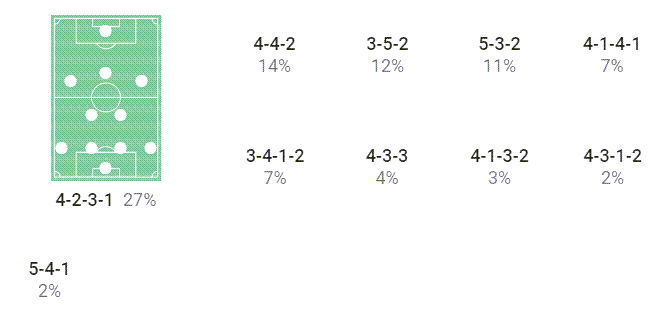
The 4-2-3-1 and the 4-4-2 were used more than any other shape but the former’s 27% usage doesn’t scream consistency.
Manuel Baum, former Tottenham Hotspur manager Christian Gross, Dimitrios Grammozis and even an interim spell from Huub Stevens failed to keep Die Knappen in the top flight. Four permanent captains, and one caretaker, tried to steer the boat in the right direction, yet it still sunk to the bottom of the Rhine.
We’ll get onto the team’s defensive displays in a moment, which were the main cause for relegation to the second division, but 24 non-penalty goals throughout a 34-game league is grimacing. That’s a goal rate of 0.71 per game.
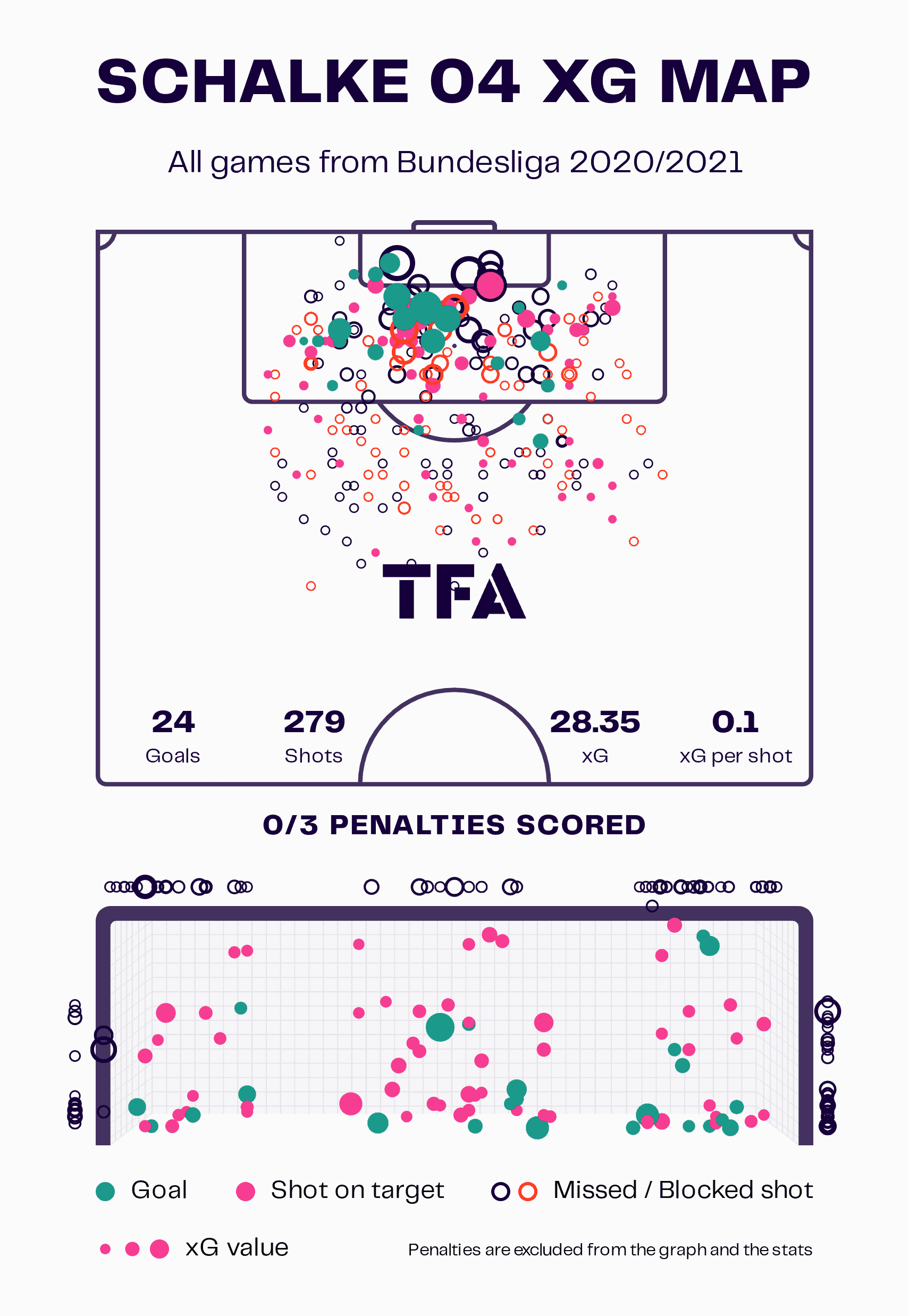
What’s worse was that, unlike the 2019/20 campaign, Schalke didn’t underperform their xG by a gargantuan margin. Of course, there was still an underperformance but scoring 28 goals instead of 24 would not have had too much of an impact on a team that won merely three games all season.
The side didn’t create enough opportunities throughout the course of the league season, registering an expected assists number of 16.9 and 17 real-time assists which shows a harrowing lack of chance creation.
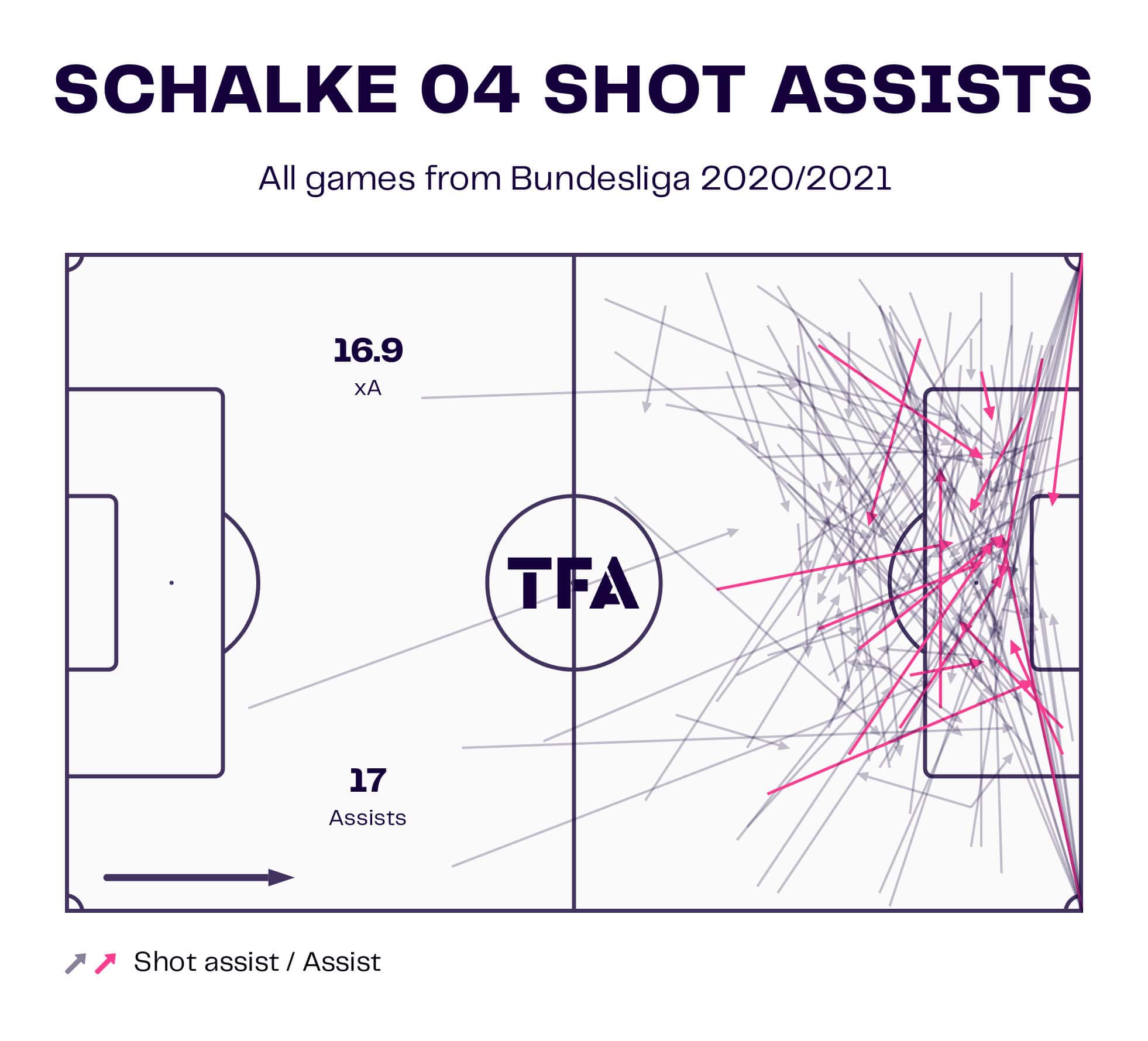
Thomas Müller alone bagged 15 assists in the Bundesliga in the very same season that Schalke went down.
Quite a lot of the chances created by the fallen giants were from corners and set-pieces in general which is far from ideal when attempting to score goals from open play.
Nevertheless, scoring goals wouldn’t have really mattered anyway, even if Schalke had increased their goal count by double the amount. No team can stay in a division while conceding such a high quantity of goals.
Over the course of the 2020/21 behind-closed-doors season, Schalke conceded 86 goals in the Bundesliga. That is 2.53 goals against per league game, a completely unsustainable record in the fight for survival which Schalke found out the hard way.
Throughout the reigns of the five different men who took charge of the team during the season, Die Knappen defended incredibly deep on average, closer to their own penalty area than the halfway line.
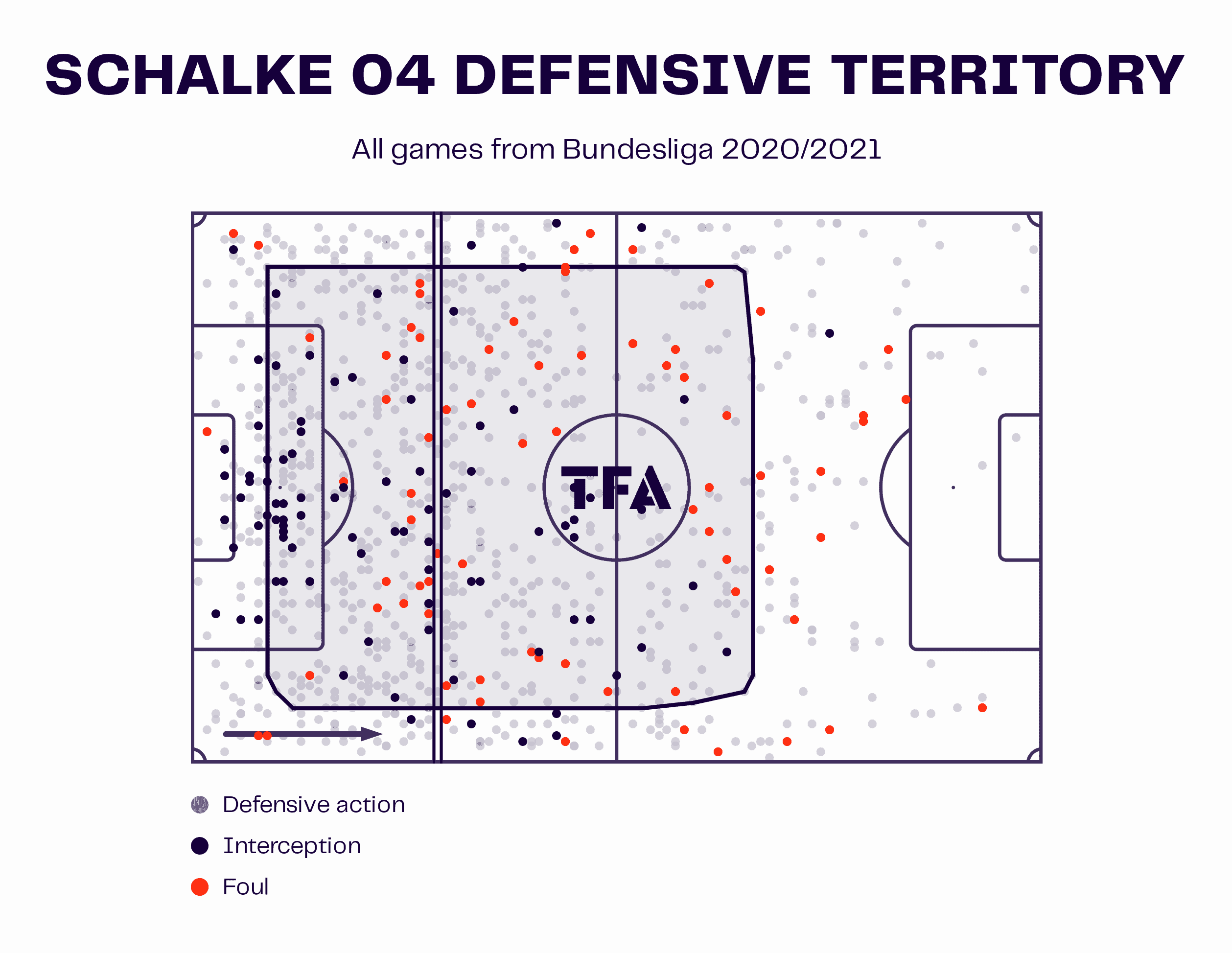
There were also very few defensive actions present in the final third, telling us that Schalke didn’t press high up the pitch much at all and preferred to drop back into a compact defensive block, although ‘compact’ may have lost all meaning here.
The Gelsenkirchen club relied on their medium-to-low block structure to keep the opposition out at the other end. This was particularly true once Wagner eventually parted ways at the beginning of the campaign.
What’s even scarier is the fact that Schalke’s goalkeepers prevented 9.03 goals for the Bundesliga campaign, conceding an xG of 82.03 in the process.
A decade before this relegation, Schalke were one of the most menacing sides in Europe, playing a Red Bull-inspired style of football under Rangnick before the German professor even got his hands on the conglomerate. 10 years on, they had been deduced to the 2. Bundesliga, winning merely 8.82% of their games that season.
Schalke ended up rock bottom but to add insult to insult to injury, Werder Bremen, who went down simultaneously, were 15 points clear of the former champions of Germany. Schalke had been relegated without a whimper and the future of the football club looked highly uncertain in the most excitingly cruel way imaginable.
Bounce back – 2021/22
Relegation can be an abject wasteland for any club succumbed to its wrath. The English football pyramid is a primary example of this desolate wilderness where teams go down and never come back up.
Bolton Wanderers, Ipswich Town and Swindon are just a few examples of teams that were relegated from the top flight and have been forced to float around the vacuum of the Football League for what seems like an eternity.
German football has its own Boltons, Ipswichs and Swindons. Hansa Rostock are a perfect example of a mainstay in the Bundesliga who slid further and further down the pyramid, yet to return. However, this wasn’t the first time Schalke suffered relegation. In fact, it was their fourth, but the club hadn’t seen an event like it since 1988. It took three years for Die Knappen to bounce back from that consignment.
Nevertheless, this time, Schalke surprised everyone and bounced straight back despite losing a whole host of first-team players upon relegation. Not only did they immediately return to the promised land, but did so by winning the entire second tier.
But it wasn’t all smooth sailing. Schalke kept Grammozis in charge, the man who took the ship down in the season before. However, with the club’s promotion bid wavering by the beginning of March, the Greek tactician was dismissed, with club legend Mike Büskens taking control for the remainder of the campaign.
Büskens did a wonderful job for the few weeks he was in charge as Die Königsblauen eventually went on to achieve promotion, lifting their first piece of silverware in over a decade, in the German’s third stint at the helm on an interim basis.
Since there was little time left in the season when Grammozis lost his job, the style of play was very similar to his predecessor, with the 3-5-2/5-3-2 being the preferred formation at Schalke throughout the season, seeing a 65% usage.
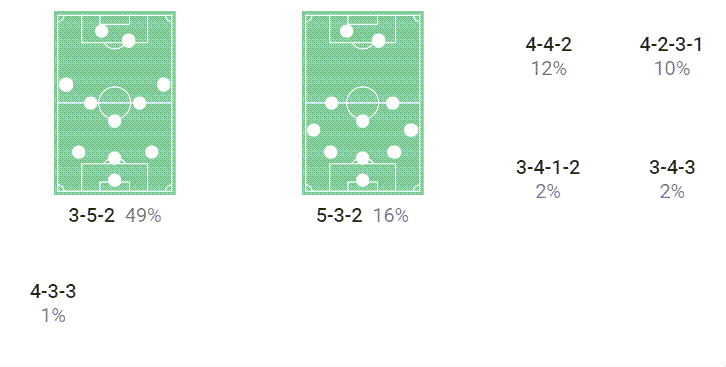
The 4-2-3-1 and 4-4-2 were still constantly rearing their heads too, as they did during the nasty relegation campaign, but both Grammozis and Büskens believed the 3-5-2 got the most out of the players available at their disposal. They were right, given that Schalke lifted the league title.
Schalke defended much higher up the pitch in the 2021/22 season and showed a greater willingness to press in the final third as opposed to the campaign prior.
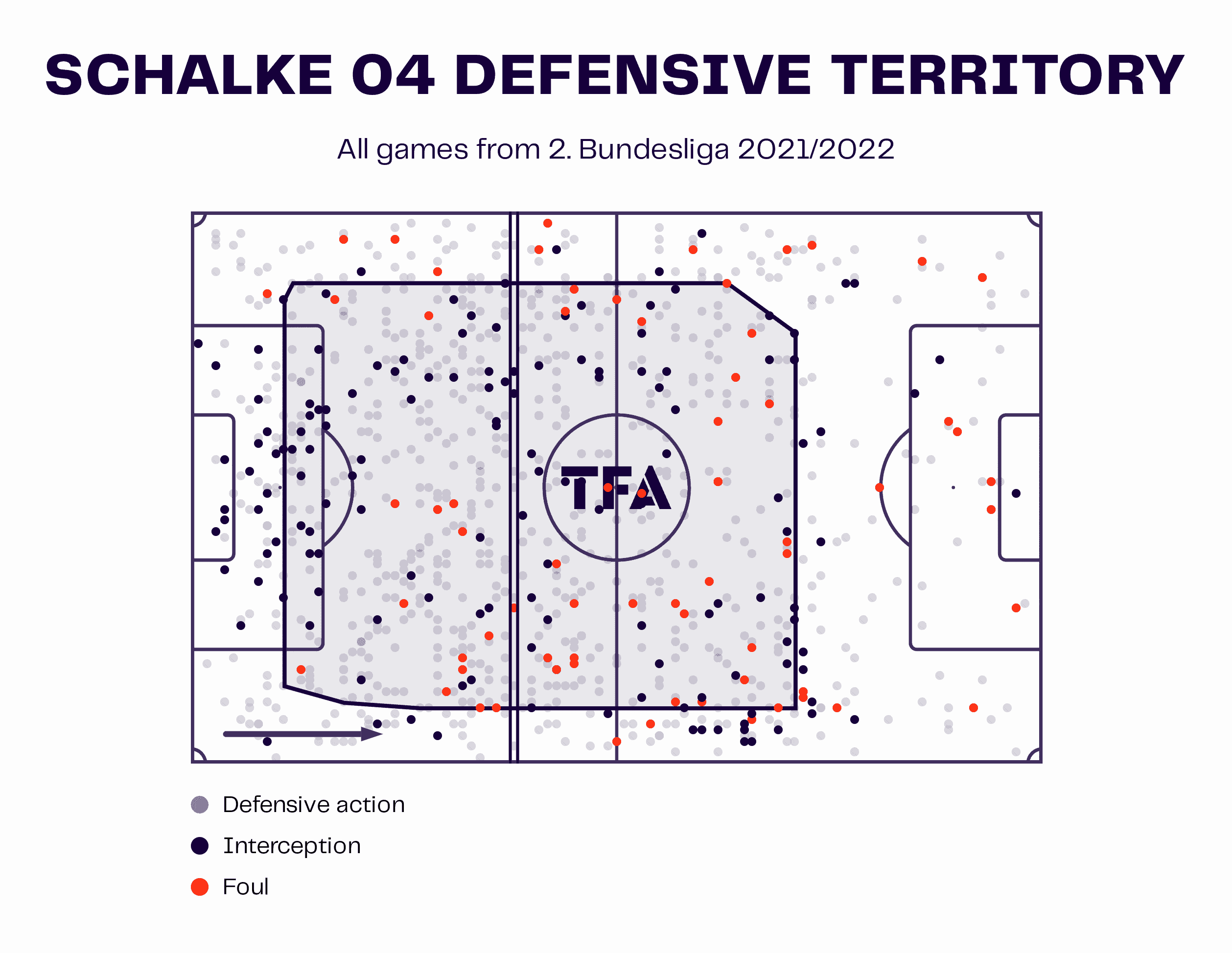
There were more defensive actions in the final third overall and the average height of the defensive line was much higher up the pitch.
Overall, Schalke registered 349 high regains in the opposition’s half as well as 163 dangerous recoveries. However, what was more exciting was just how good Die Knappen were at recovering the ball during opponent counterattacks, more commonly referred to as counterpressing.
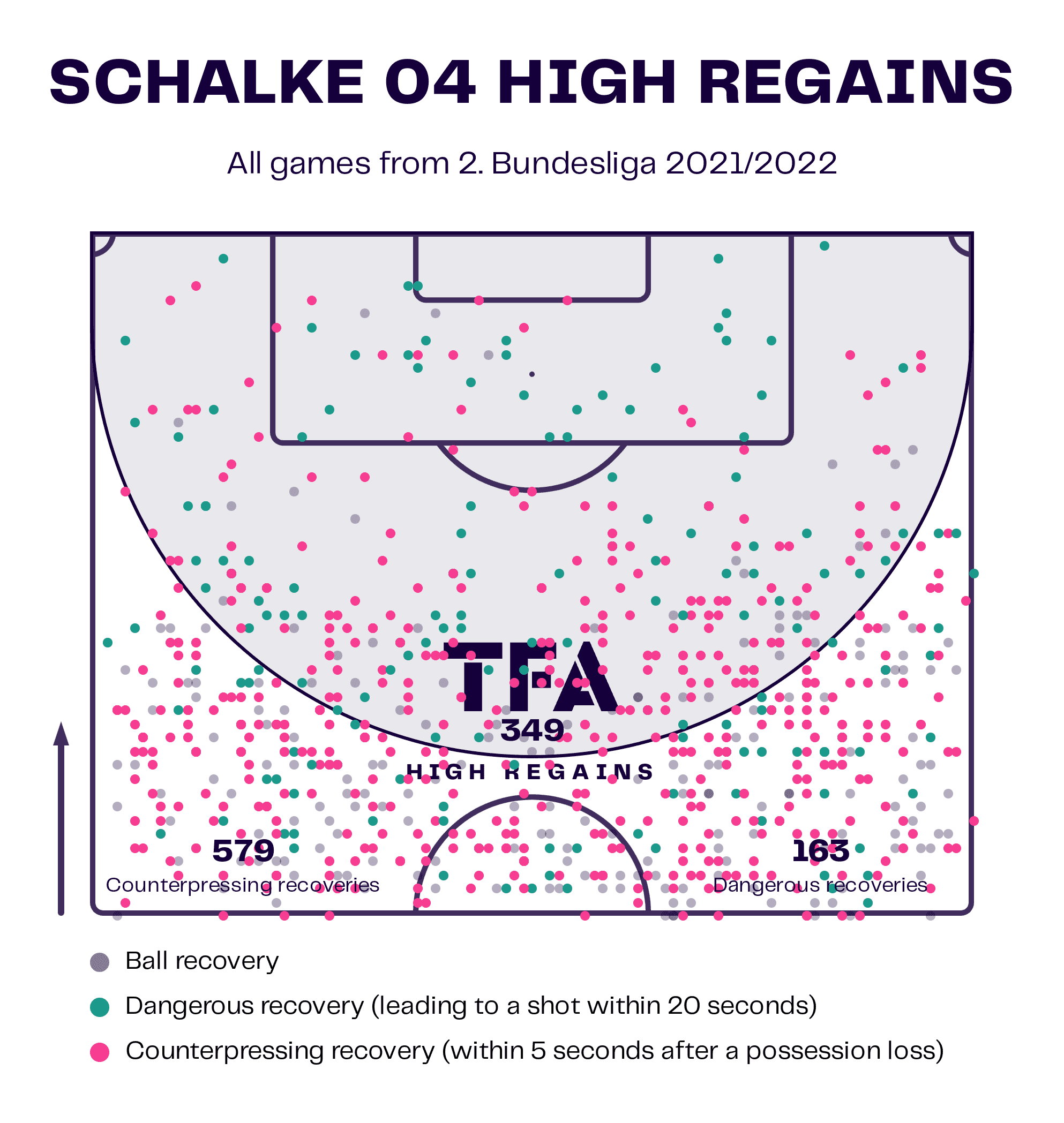
Schalke boasted 579 counterpressing recoveries in total and ended the title-winning season with the joint-third best defensive record in Germany’s second division, conceding 44 goals in the 2. Bundesliga, which was just about half of the goals that flew past them last season.
Moreover, the side’s ‘xG faced’ dropped by more than half, down from 82.03 xGA from the season before to 40.57, although the goalkeepers underperformed which means that the total number of goals conceded could have actually been even less.
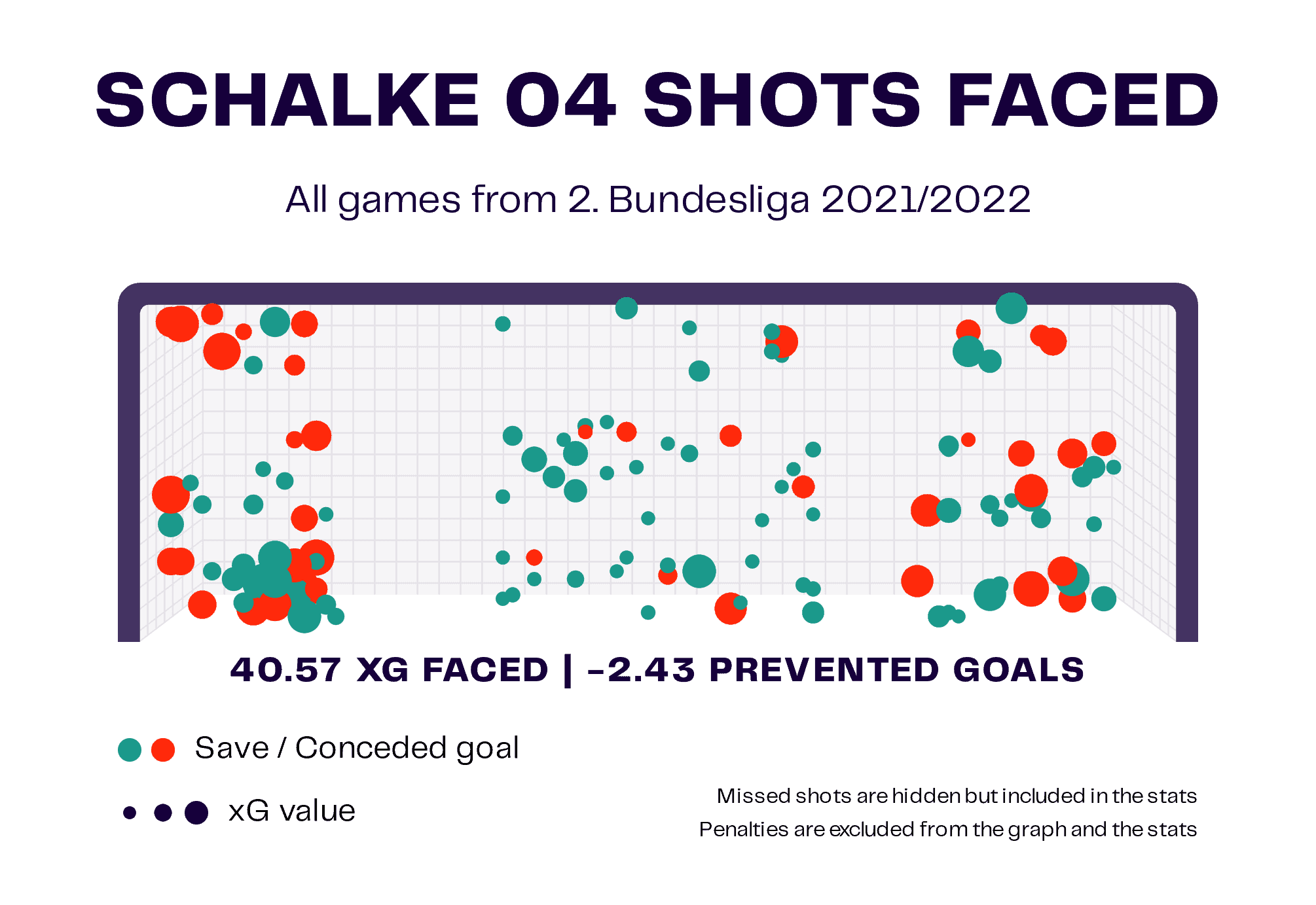
Even more impressively, Schalke almost tripled their goals tally from the season prior, scoring 72 goals in total which put them first in the goalscoring charts. This high increase in goals was helped by the excellent recruitment of Simon Terodde who was acquired after bagging 24 goals in 33 games in the same league for VfB Stuttgart.
Terodde’s tally in North Rhine-Westphalia was even more exhilarating as the 6’4” centre-forward put the ball in the net 30 times in the 2. Bundesliga.
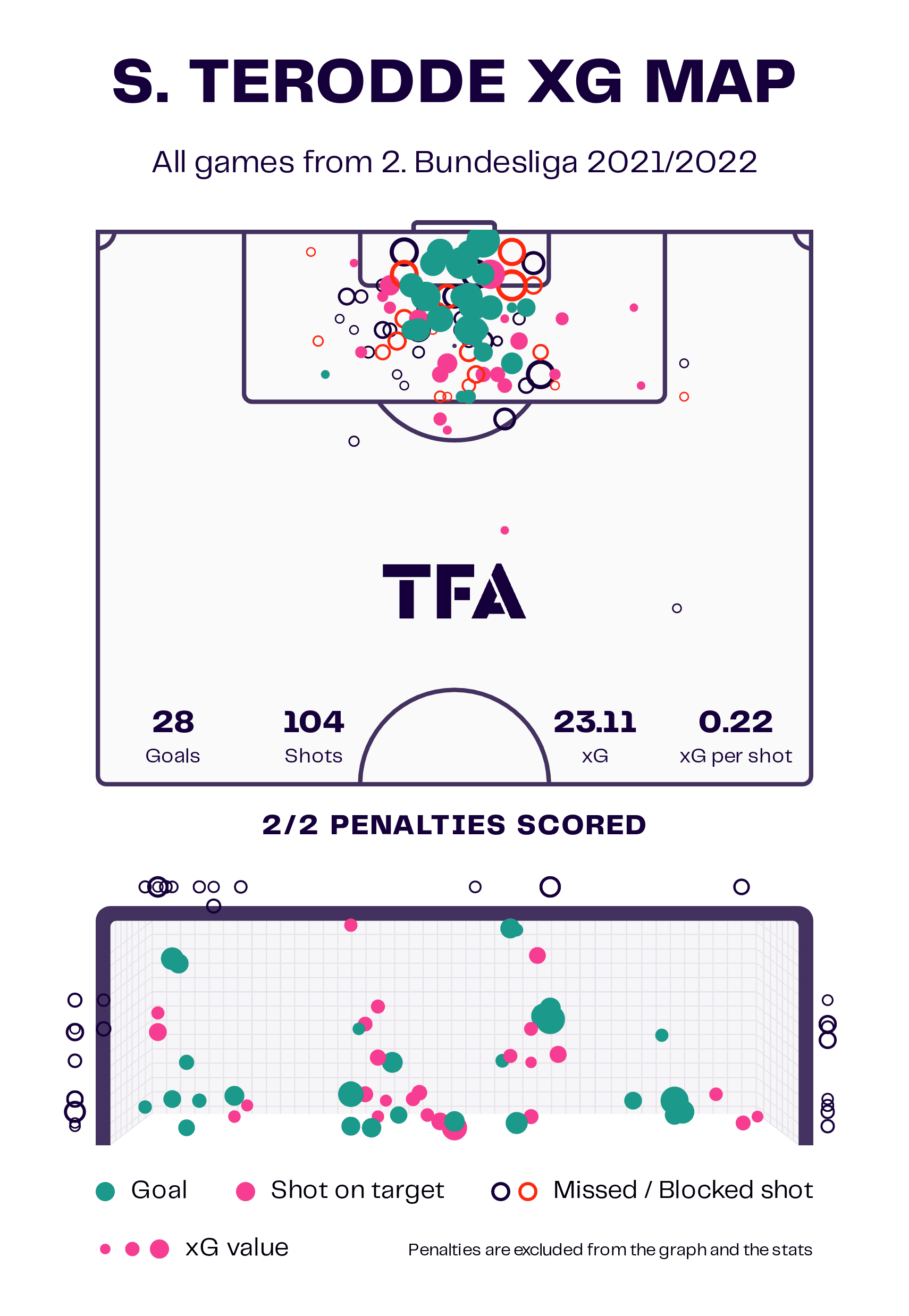
Schalke always looked to move the ball out wide during the attacking phases, using the wingbacks to hold the width of the pitch and to put crosses into the penalty area. This played to the strengths of the colossal Terodde who is dominant in the air and is a handful for any opposition defender.
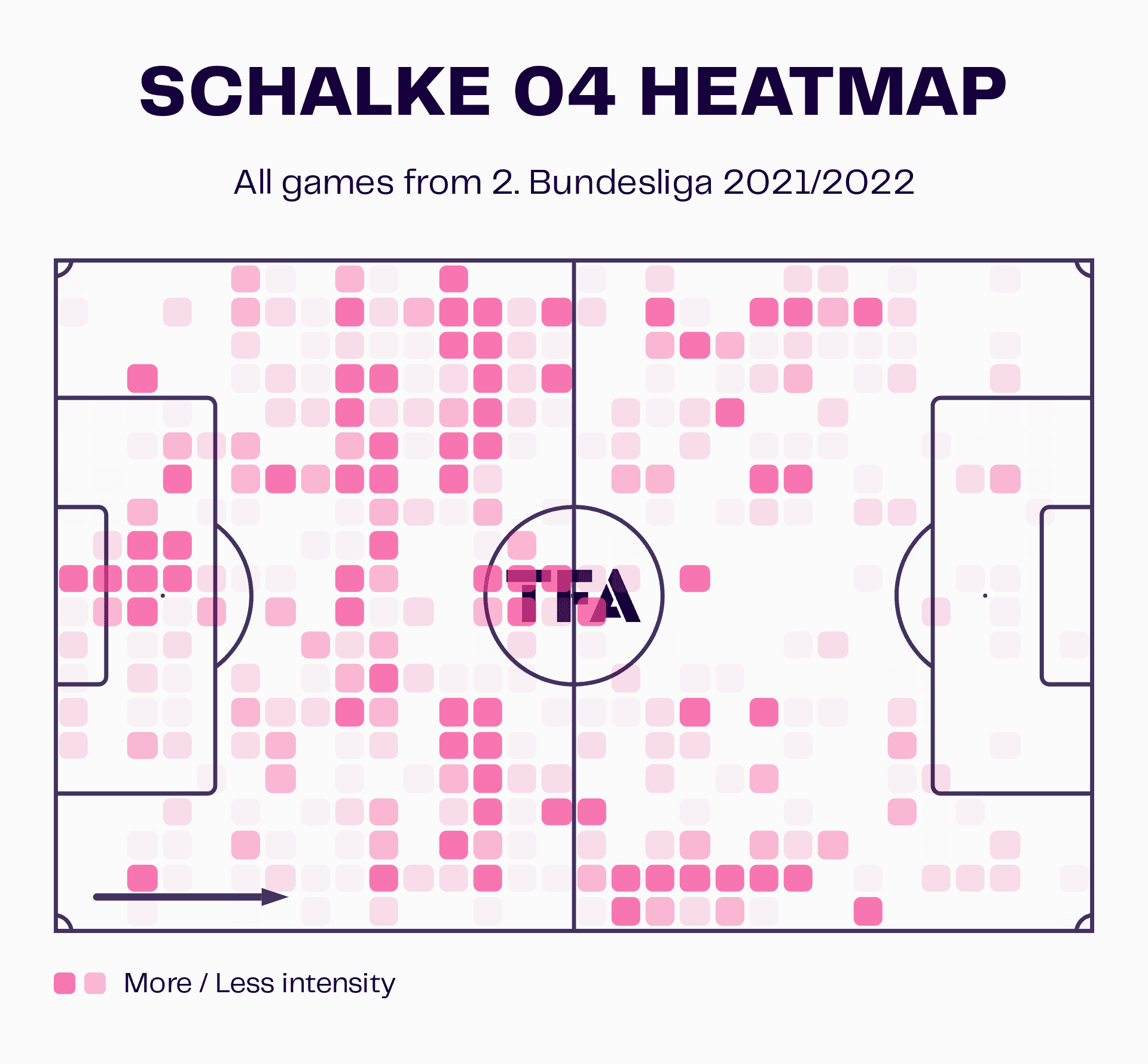
From Schalke’s heatmap throughout the 2021/22 campaign, it is evident that the densest areas of the pitch where Die Knappen had the ball the most were the wide spaces, particularly in the opposition’s half of the field.
To back this up even further, all we need to do is take a look at the side’s shot assists map this season which increased almost three-fold from the horror show of the 2020/21 season.
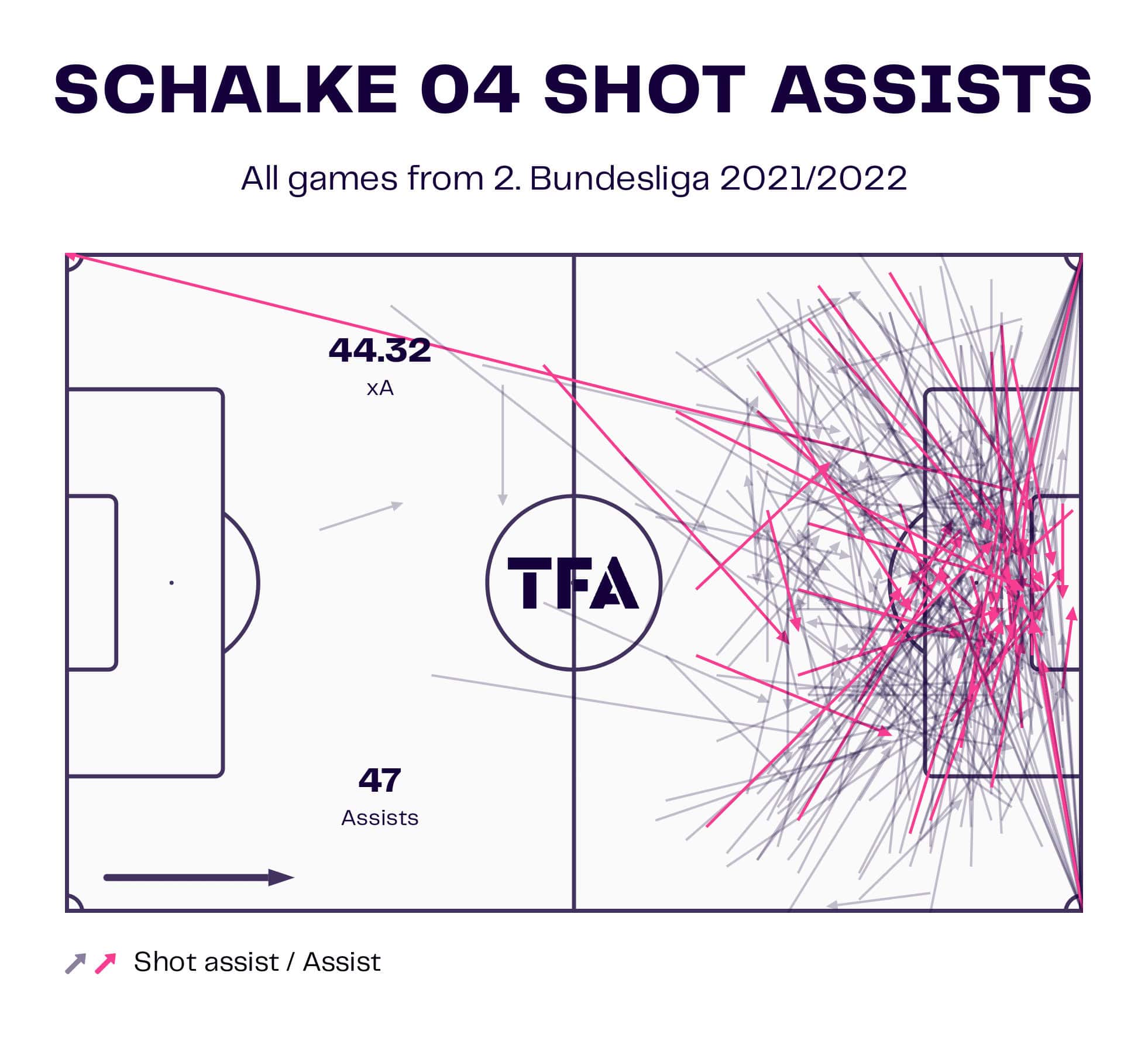
The overwhelming majority of Schalke’s chances throughout the season under both Grammozis and Büskens came from the wide areas, whether they were from corners or just whipped balls into the middle from the wingbacks.
Schalke were creating chances in abundance, scoring goals like they were going out of fashion and were more solid defensively, without chopping and changing formations regularly.
Amid uncertainty, doubt and ambiguity, the board managed to find stability and Die Königsblauen clinched promotion in early May with a 3-2 victory over St. Pauli, having come from two goals down. A week later, they were crowned champions. What a turbulent twelve months which concluded with a happy ending…
No such thing as a happy ending – 2022/23
It was a fresh start for Schalke. Büskens took a back-seat on the coaching staff while the board appointed experienced coach Frank Kramer, a former German FA youth coach and the man who relegated Arminia Bielefeld last season from the Bundesliga.
The club underwent serious surgery to the first team, with a whole host of new players coming to the Veltins-Arena while many also headed out in the opposite direction.
Players such as veteran Premier League defender Maya Yoshida, fullback Thomas Ouwejan, Kenan Karaman, Sepp van der Berg, Alex Král and many others were signed on permanent and temporary bases to strengthen the squad to be able to deal with the step up from the 2. Bundesliga.
The aim was survival for the first season. Unfortunately, things got off to a horrendous start. Schalke were second from bottom by mid-October, and Kramer was dismissed as head coach, making him the sixth manager to lose his job at the club in two years.
Kramer’s style of play didn’t quite resonate with the players. His philosophy was one of pragmatism and certainly didn’t appease the purists. At times, it could make for an incredibly gruelling watch.
In the Revierderby versus Borussia Dortmund, Schalke had an xG of merely 0.19 which included no shots on target, to complement their 35% possession. They set up to frustrate Dortmund, not to trouble them at the other end. This was made all the more frustrating when Dortmund snagged a late winner with no reply from their not-so-noisy neighbours.
In general, Kramer’s football was really direct, relying on long balls up the pitch and winning the second balls.
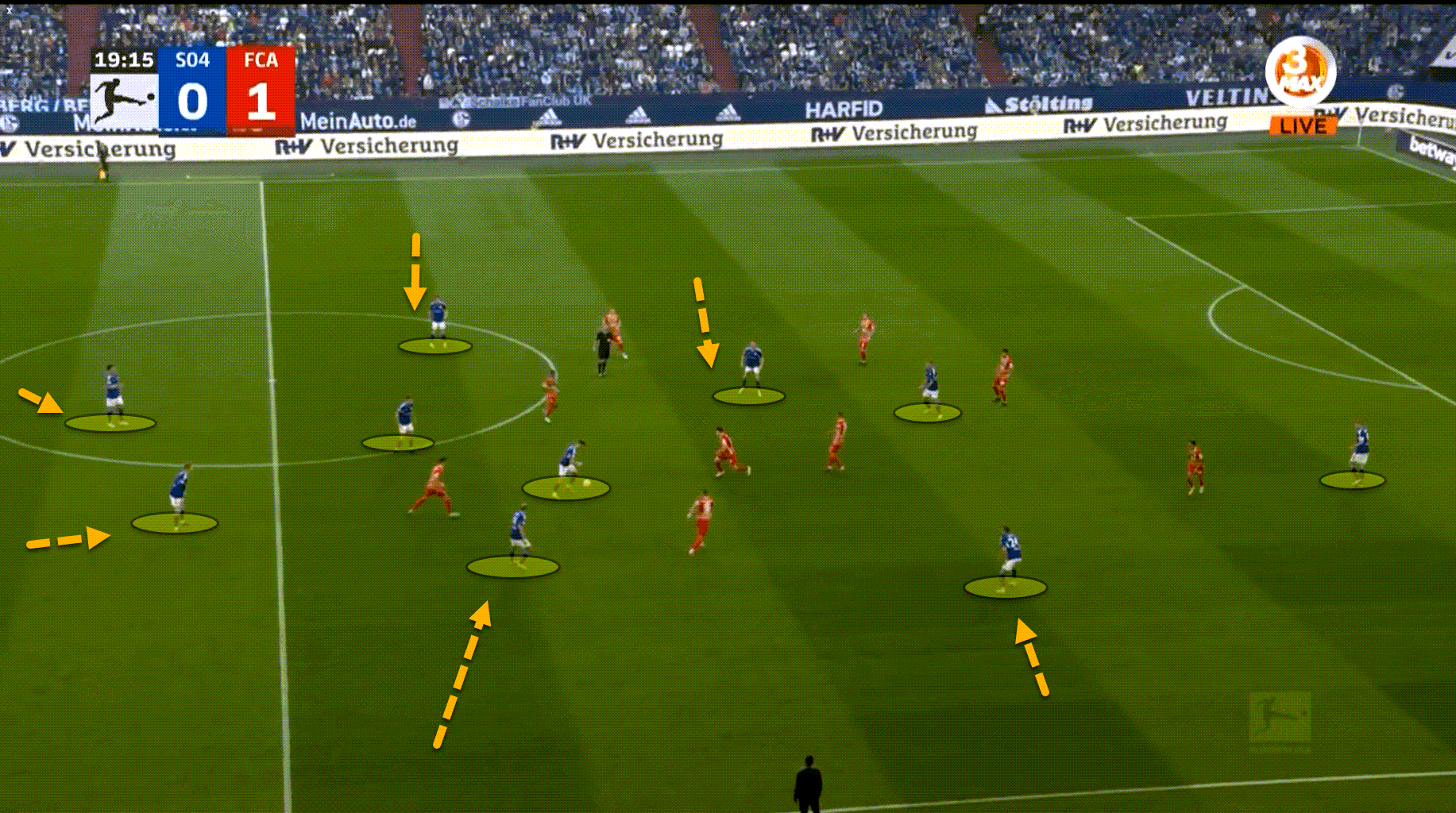
Here, instead of trying to build up from the back, the Schalke goalkeeper pumped it up the pitch while the rest of the players squeezed together to win the second ball in an attempt to sustain an attack in a higher area.
Once the attack was maintained in this higher position, the fullbacks would get really advanced and wide to offer support from the flanks. Schalke would try to switch the ball out to these players to then cross it into the box towards Terodde.
Die Knappen’s positional attacking shape was really narrow as the wingers tucked inside, leaving the fullbacks with the bulk of the heavy lifting.
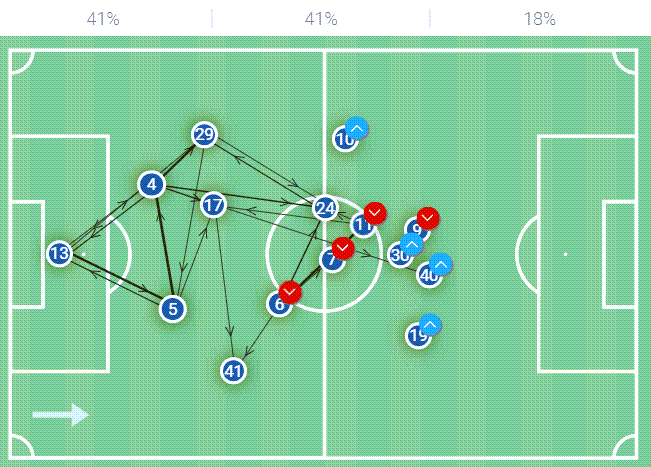
As can be seen from this passing network against Dortmund in the derby, each player from the midfield and forward line was in a narrow position despite deploying a 4-2-3-1 on the day.
As a result of the way Schalke would set up under Kramer, the fullbacks were of vital importance and the flanks were the main source of chance creation for the team, which is where most of the side’s shot assists came from.
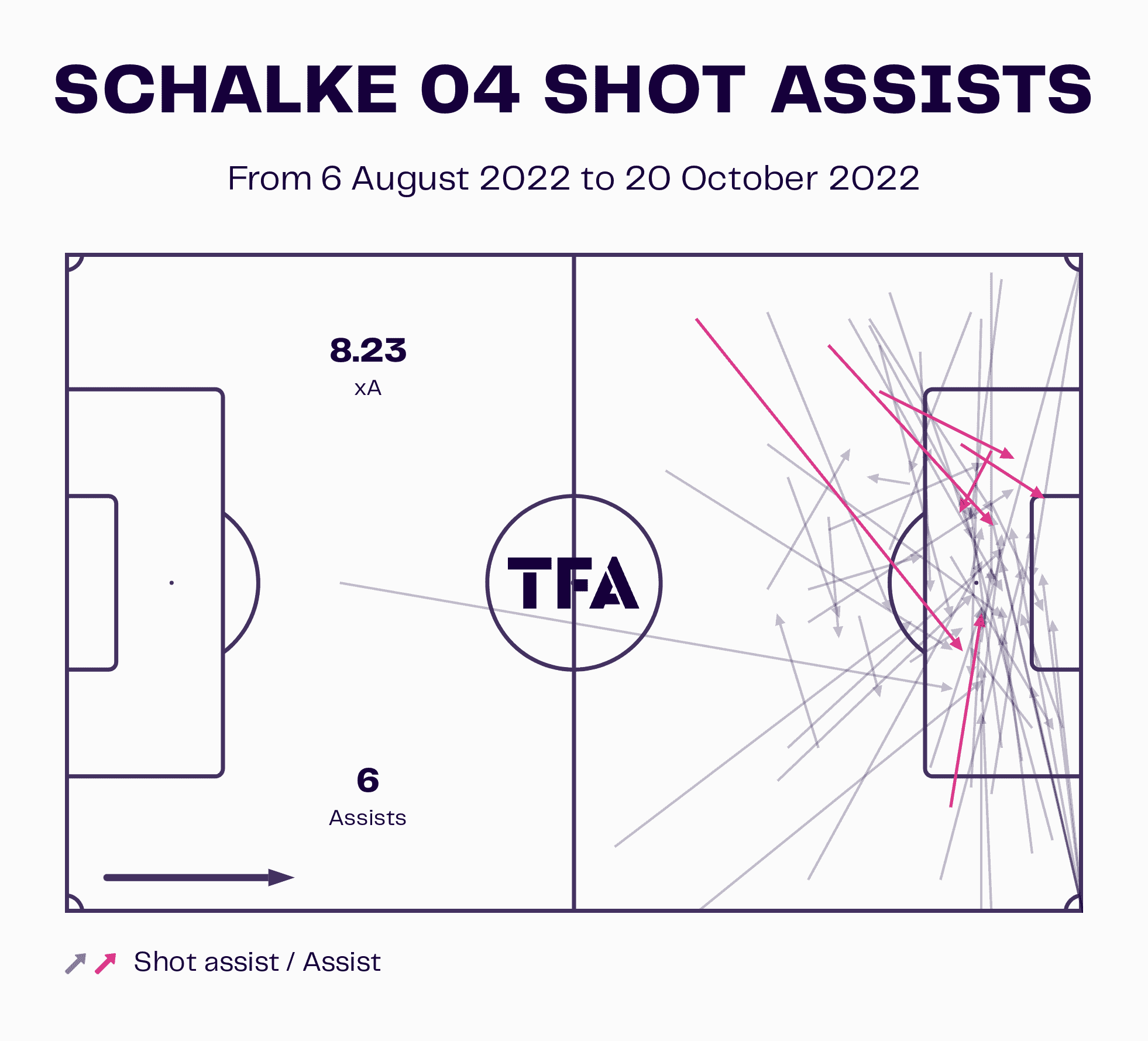
What sticks out the most from this data viz is the underperformance from Schalke’s xA numbers and their real-time assists under the former Arminia coach. This shows a real lack of goalscoring quality in the forward department as the team struggled to find the net.
One of the reasons behind this underperformance was because of the types of balls being put into the box, specifically high crosses. Crosses are a notoriously low percentage opportunity given the number of obstacles preventing an attacker from being able to convert.
If the forwards are having to convert low percentage chances, their conversion rate will be low unless they are immense finishers like Karim Benzema or Erling Haaland, but not every team has the fortune of possessing such riches.
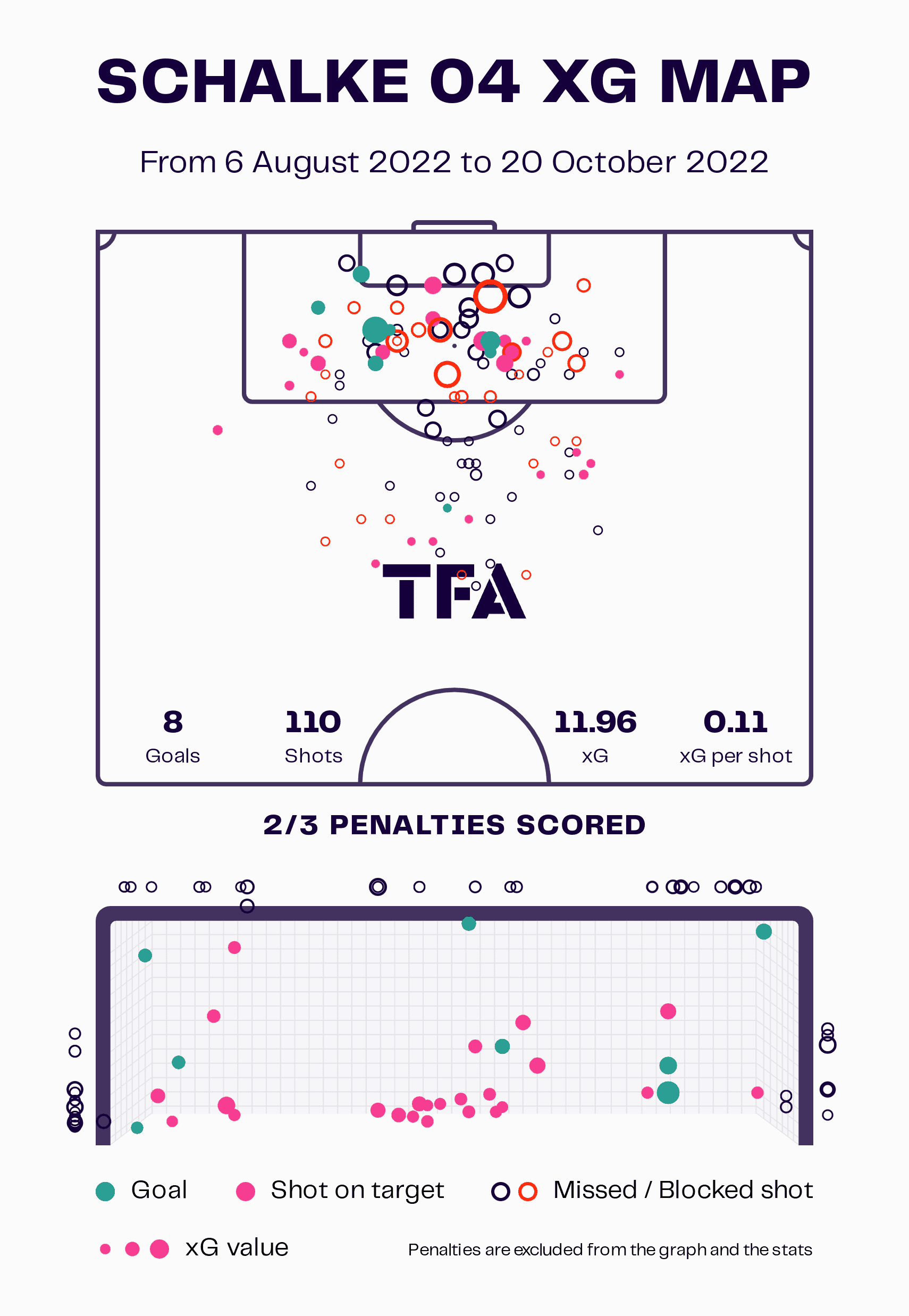
During Kramer’s short-lived reign, Schalke scored eight goals but underperformed their xG of 11.96, while registering a lowly xG per shot of just 0.11. A mix of poor finishing and one-dimensional chance creation led to the gaffer losing his job.
Nevertheless, it was not the only reason. In such a short space of time, Die Königsblauen conceded a non-penalty xG of 24.18. Schalke’s xGA was roughly double their xG which is never ideal in a relegation scrap.
Thomas Reis took over from Kramer — another manager with Bundesliga experience, having coached VfL Bochum for three years from 2019 to 2022, helping the German minnows back to the Bundesliga in 2021 with a squad that included current Southampton centre-back Armel Bella-Kotchap.
Reis didn’t make radical changes. In fact, his football wasn’t overly dissimilar to his predecessor, if not a little more attack-minded, but the formation remained the same as the 4-2-3-1 has comfortably found its home in Gelsenkirchen this season.
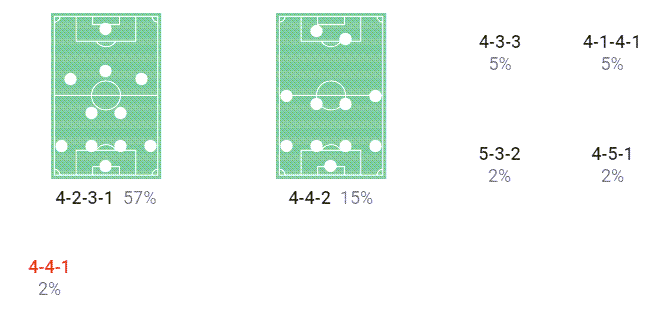
There are a few differences in how Reis’ setup contrasts with that of Kramer. The latter’s team played quite direct, but the aim was to sustain an attack in the final third and then attack the flanks.
Under Reis, Schalke often use long balls as a method to create opportunities in the penalty area but play long to the frontmen to win flick-ons or to knock the ball down to a supporting teammate.
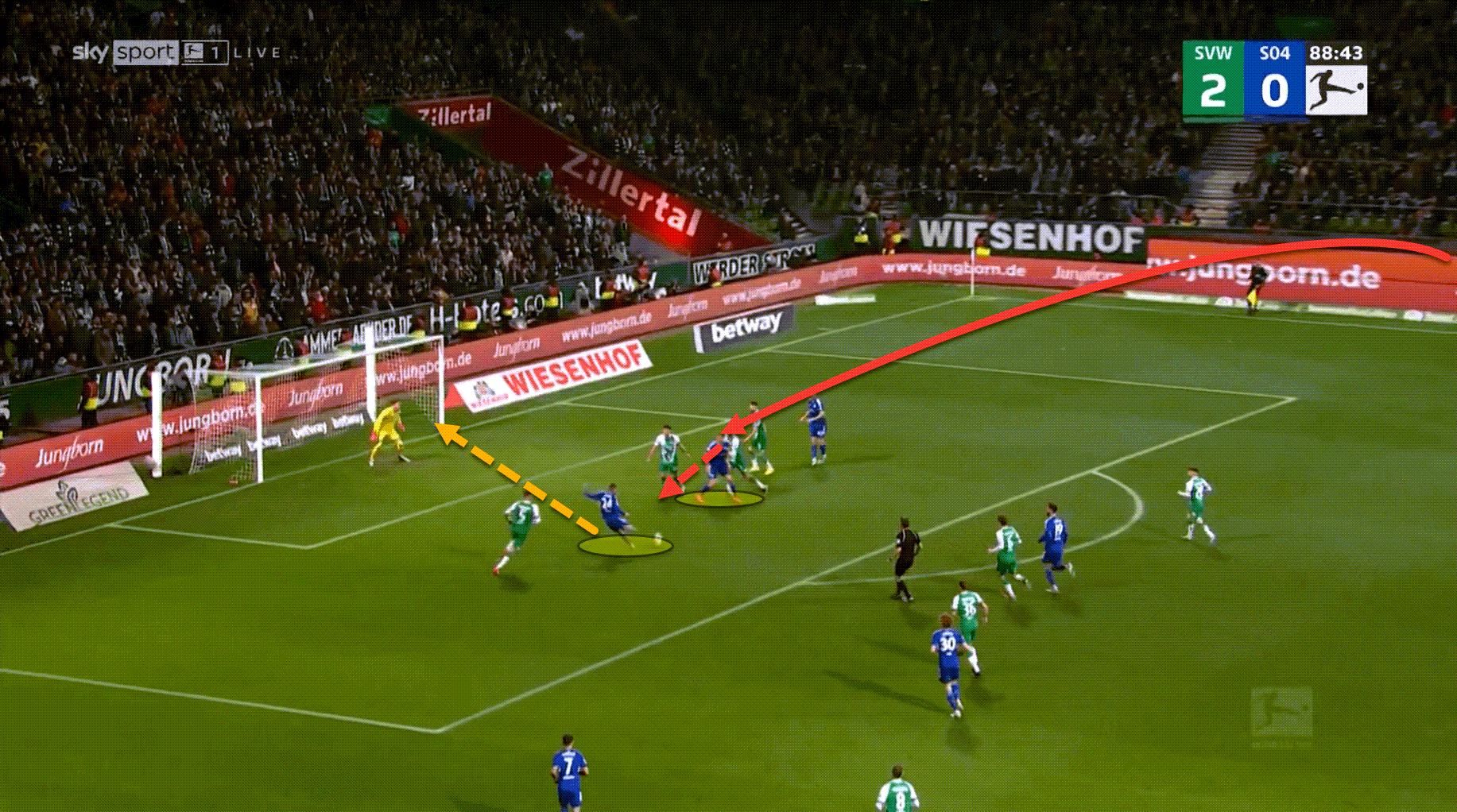
Here, the ball was pumped from the backline to the head of the striker in the box who knocked it down, allowing his teammate to latch onto the cushioned header and smash it past the goalkeeper. Such a simplistic, yet effective method of scoring goals once the right personnel are in place.
Playing out from the back isn’t really an option for Die Knappen, particularly when pressed high by the opposition. As a result, Ralf Fahrmann kicks it long on an almost constant basis. All of the Schalke keeper’s progressive passes this season have been long passes.
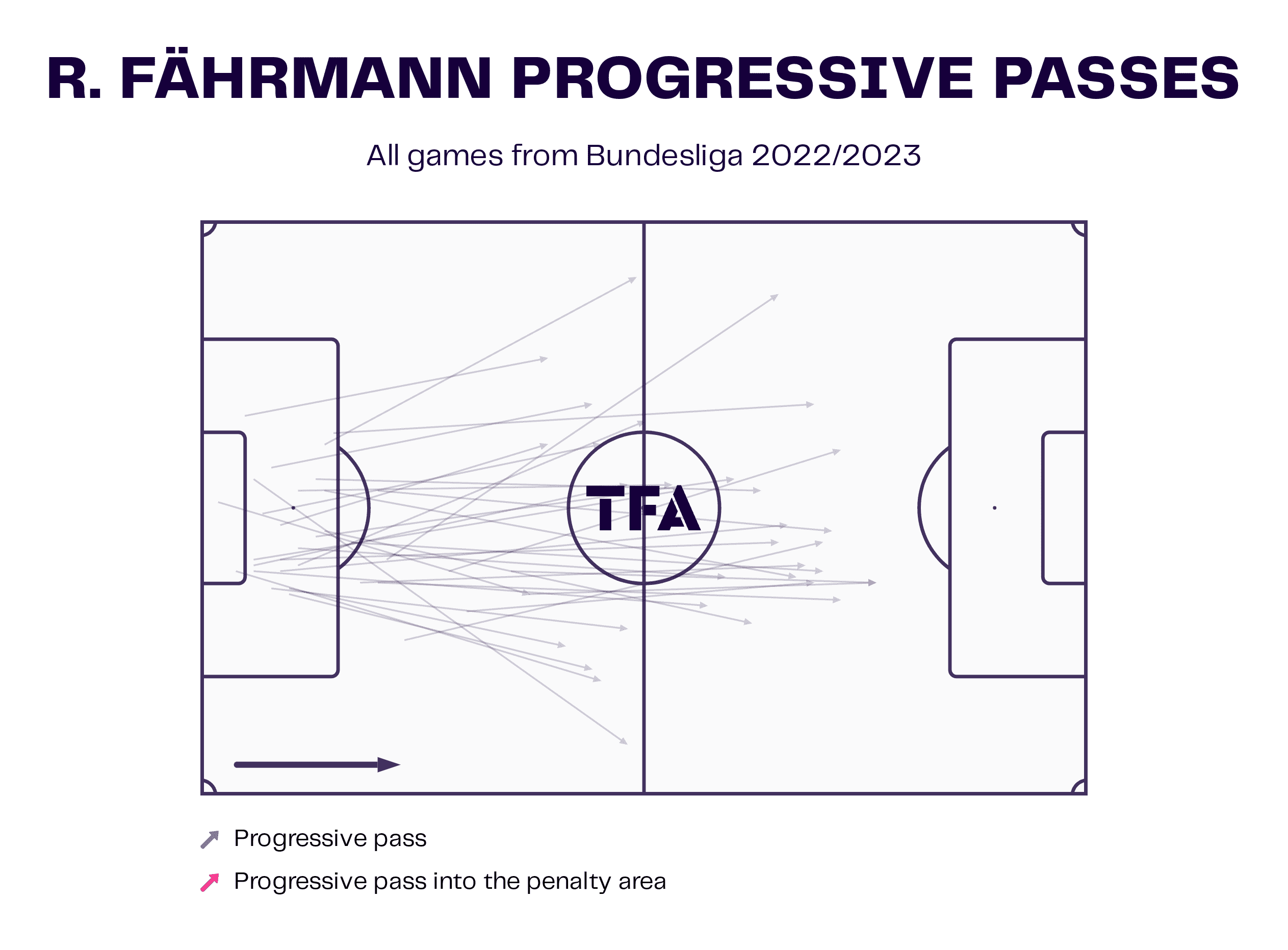
Reis’ Schalke are also far more intuitive and well-drilled in transition and are quite threatening on the break.
Normally, as soon as possession is won, Schalke look to be as direct as possible towards the opposition’s goal. The objective is to get the ball forward quickly, meaning the forwards run in behind, looking for balls over the top to be a threat from counterattacks and to play off of one another.
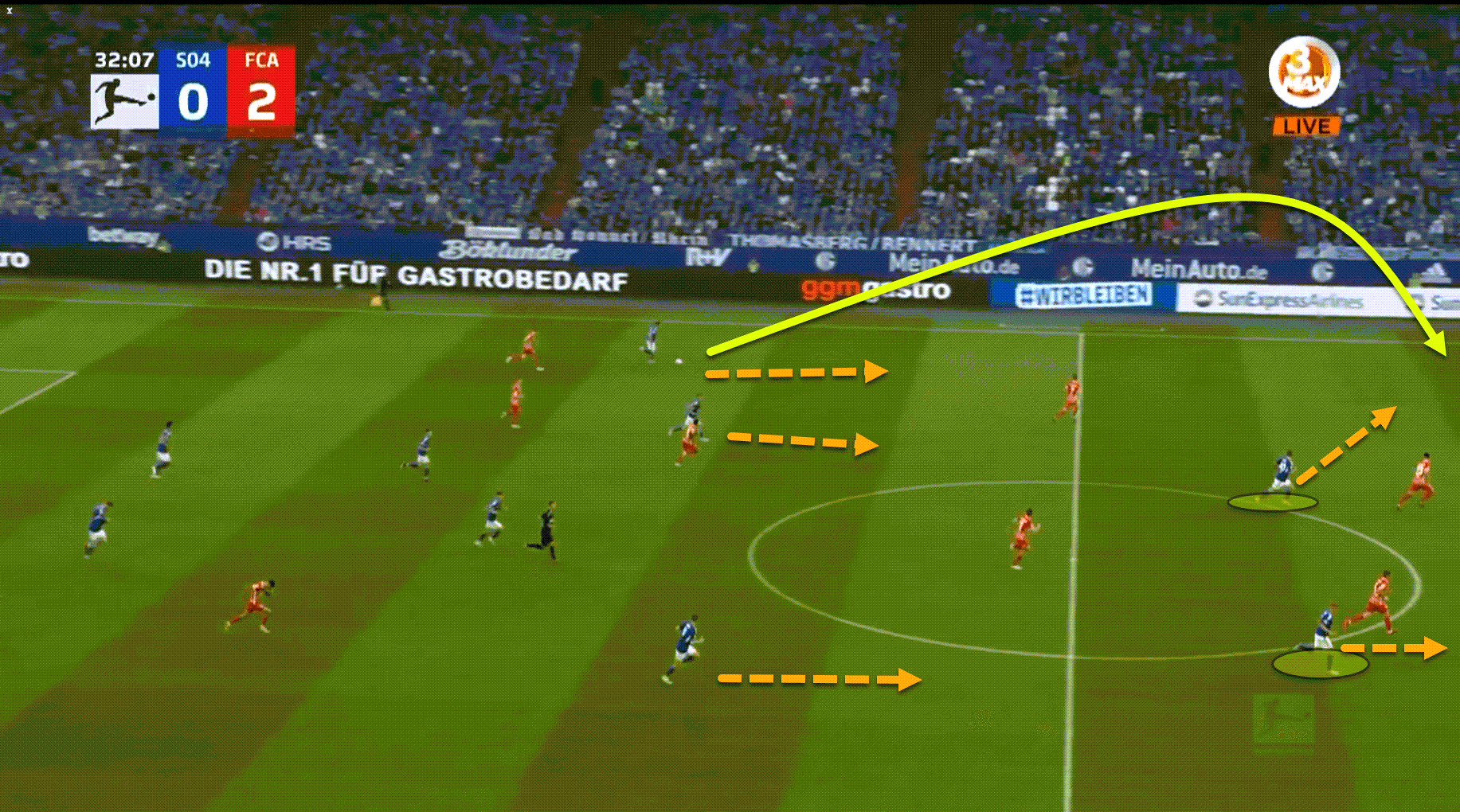
However, while there is more variety and structure to how Schalke attack, the team are severely underperforming their xG stats, bagging just 11 goals in all competitions under Reis’ reign from an xG of 20.83. This is an underperformance of almost double the amount.
The side’s average xG per shot has actually declined during his spell in charge too, dropping from 0.11 under Kramer to 0.1 under his tutelage. It’s a minimal reduction in chance quality but margins like this really matter in elite sport.
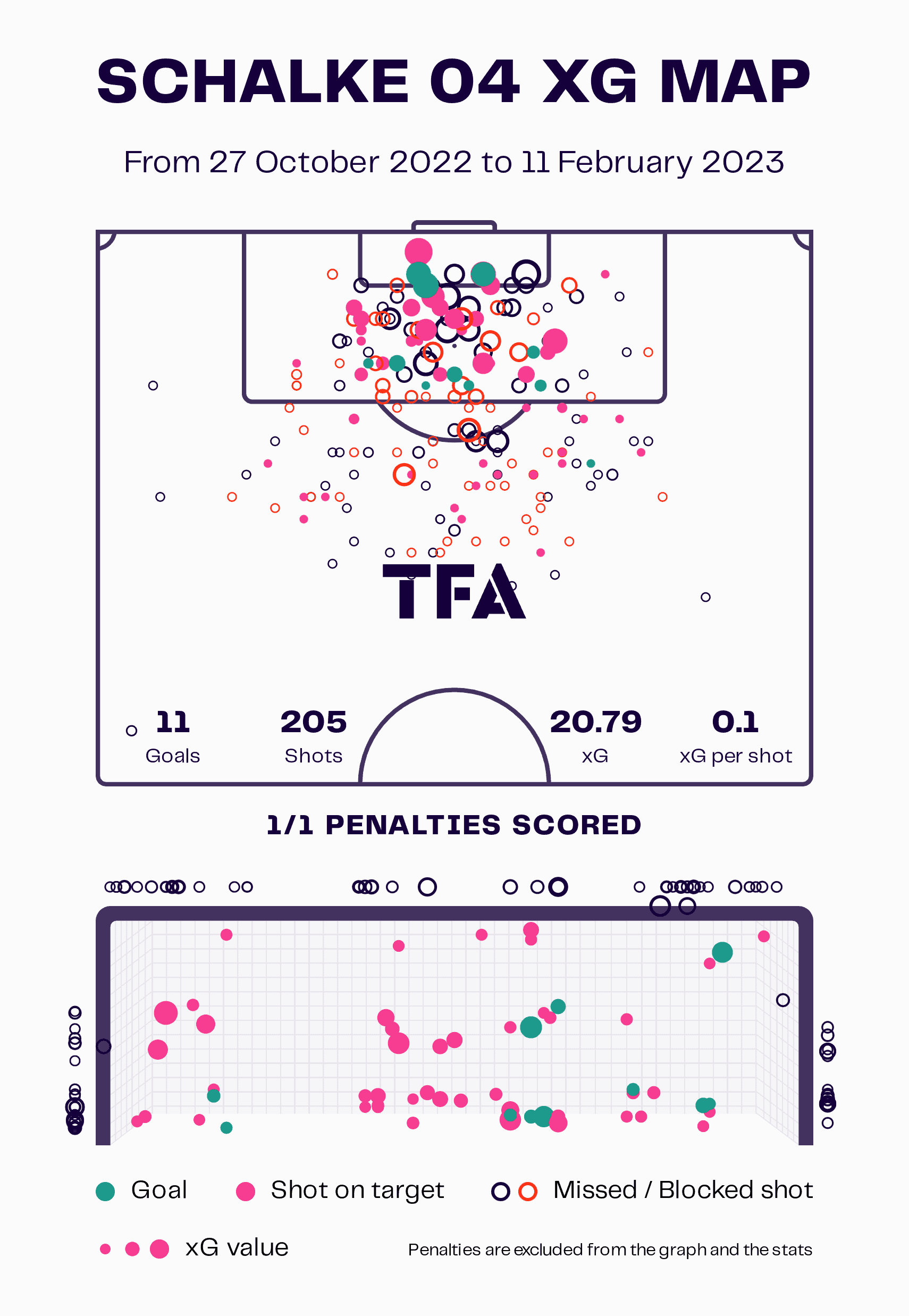
Schalke have scored just three more goals lot more time than Kramer was given. Somehow, the team’s performances in front of goal actually declined.
What has improved though has been Schalke’s displays at the other end. The fallen giants have conceded roughly the same amount of xG as during Kramer’s tenure but in a grander space of time. The goalkeepers have also helped to prevent more goals too.
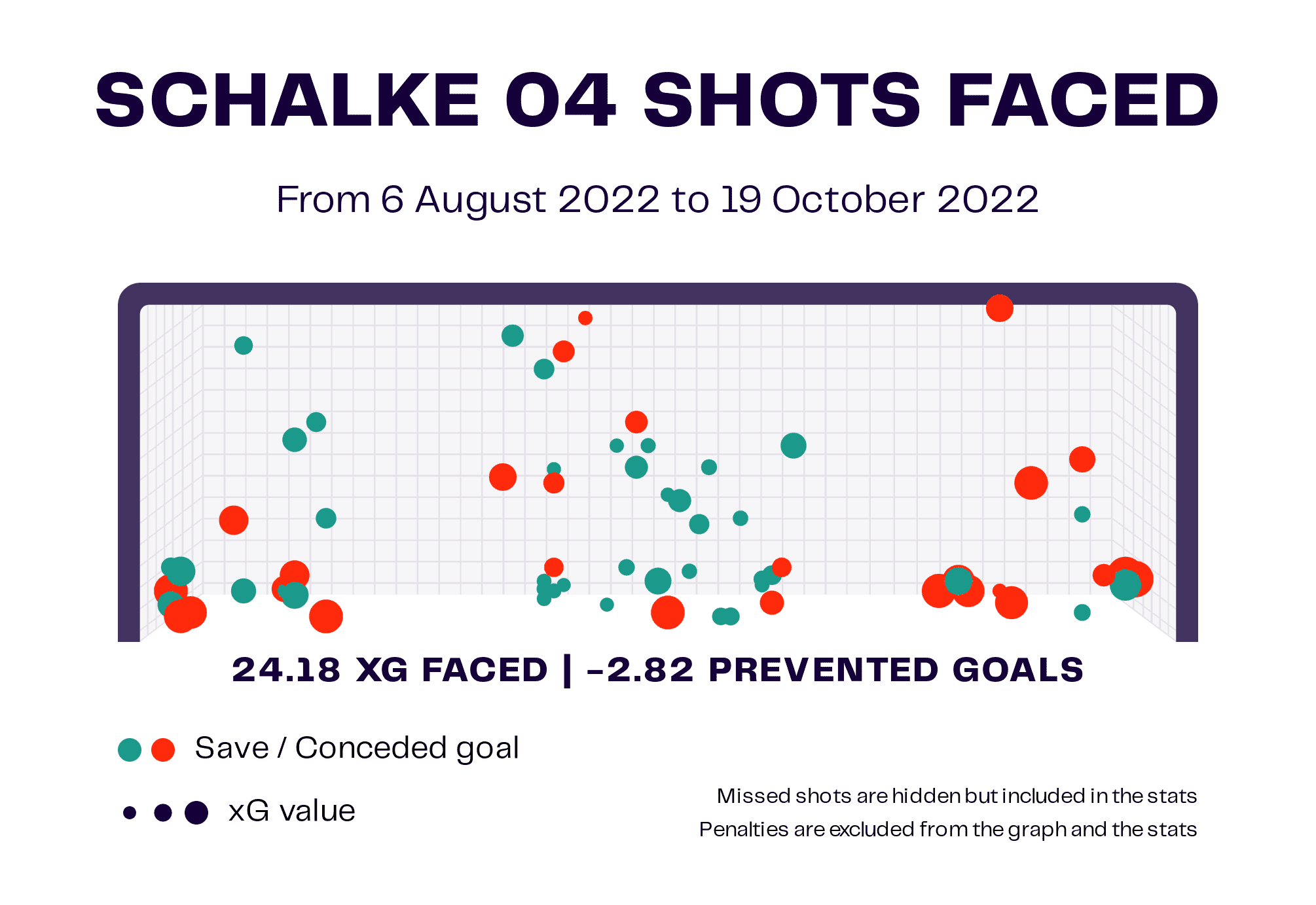
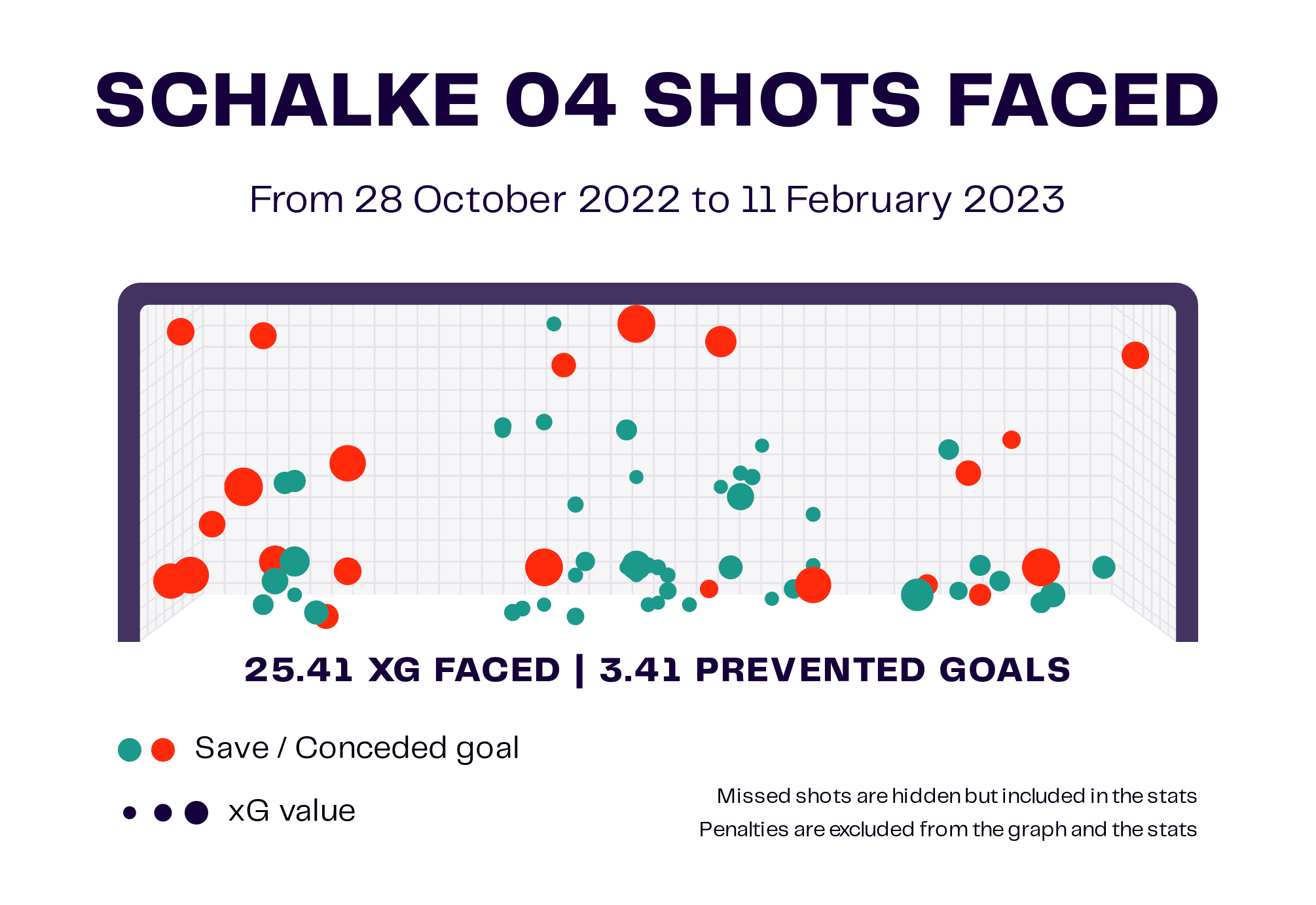
The opposition can create fewer chances against Schalke since Reis took over from his predecessor and what’s even more impressive is that the side are defending way higher up the pitch.
The average defensive line of Schalke since Reis took charge back in October is very close to the halfway line and there are quite a lot of defensive actions in the final third too, showing a real willingness to press higher up the pitch and to try and win the ball as close to the opponent’s goal as possible.
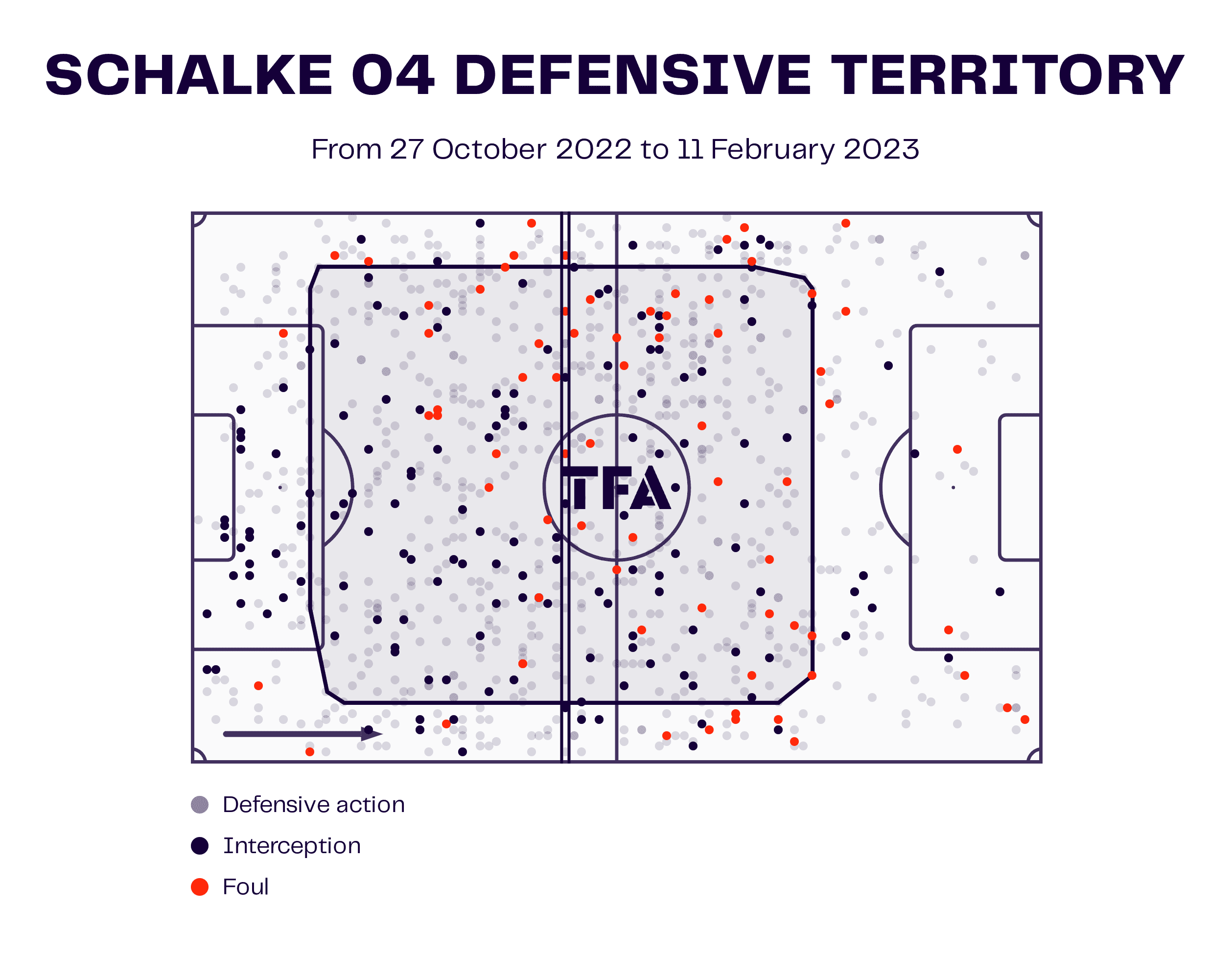
Schalke’s defence is improving quite a lot. In fact, as of writing this piece, the team have just kept three consecutive clean sheets against Wolfsburg, Borussia Mönchengladbach, and FC Köln, although each game was goalless and so if you’re a glass-half-empty kind of person, these are three important matches without scoring.
Of course, the real worry for fans of the North Rhine-Westphalia club will be that no matter how much they press, how compact they defend or how well their keepers play, the team’s failure to score goals has almost doomed them to an early relegation once again.
Schalke have scored merely 14 goals this season in the Bundesliga. Across all the top five leagues, only Sampdoria in Serie A have bagged fewer. It’s a real cause for concern for Reis, especially when their xG in Germany’s top flight currently stands at 25.62.
The only way Schalke can possibly stave off an inevitable relegation this season is by being more productive in the final third, but this is seemingly equivalent to asking a fish to climb a tree.
Conclusion
FC Schalke’s supporters had not experienced relegation to the second tier in more than three decades. Young fans of the club had never seen it at all. Now, Die Knappen look set for relegation for the second time in two years, sitting bottom right now and looking rather hopeless.
Perhaps this time it won’t hurt as much, but on the flip side, it may hurt even more because it’s the hope that kills any football supporter. That’s why we love the game and all its cruel teats.
The worst part of this relegation, once again, will be the re-emerging theme of uncertainty. While the once titans of Germany bounced straight back up last season, there is no guarantee history repeats itself.
The belly of the beast awaits. Schalke will either battle their way back to safety or avoid being swallowed whole by the looming sense of ambiguity and darkness that cowers over the club with every passing minute.

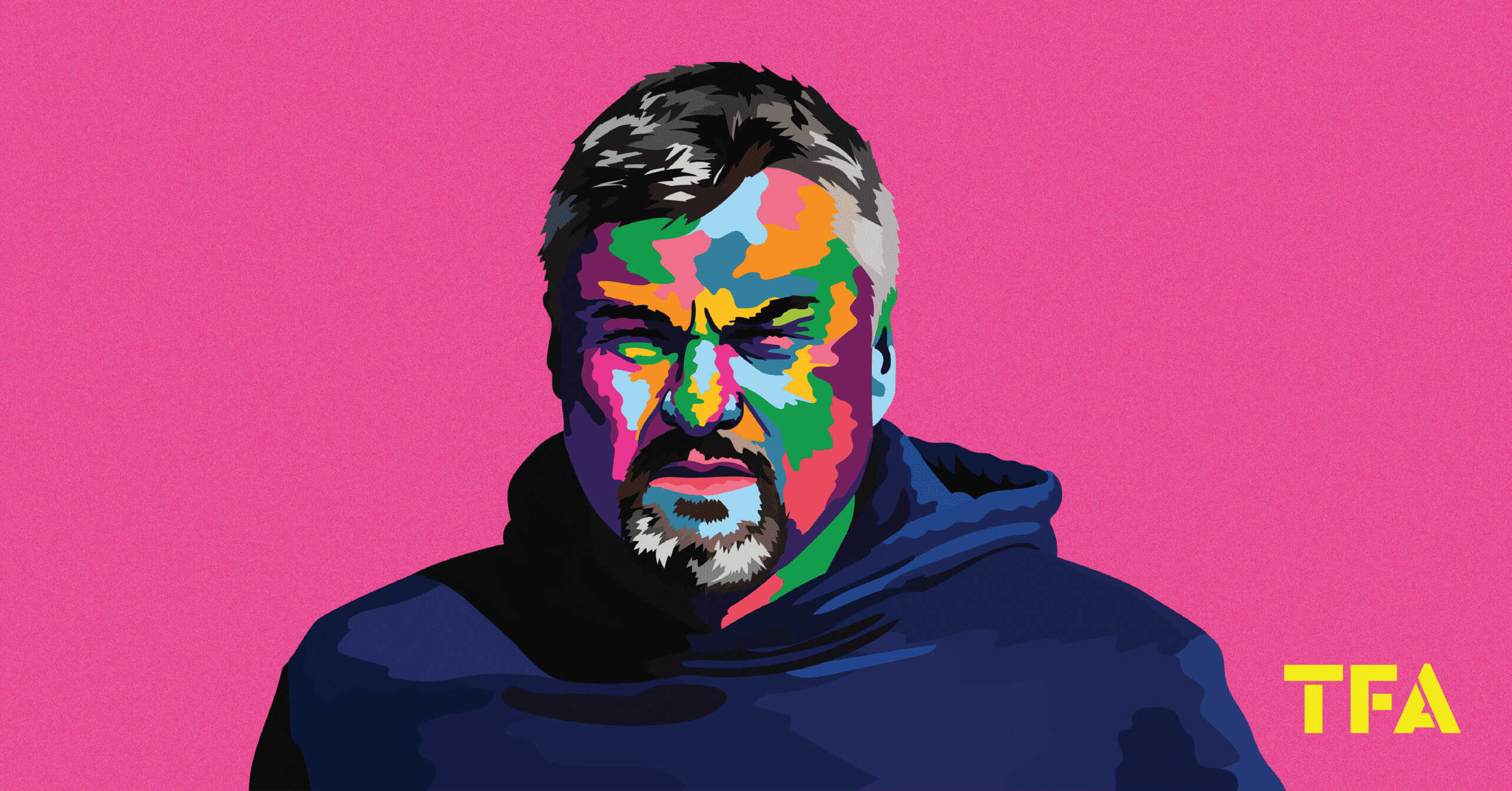




Comments